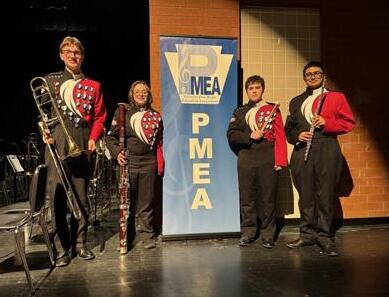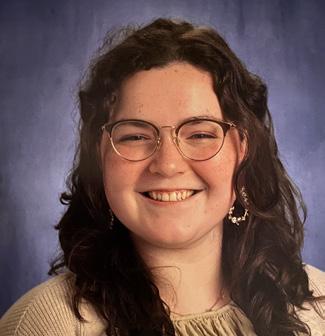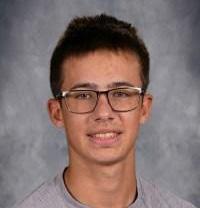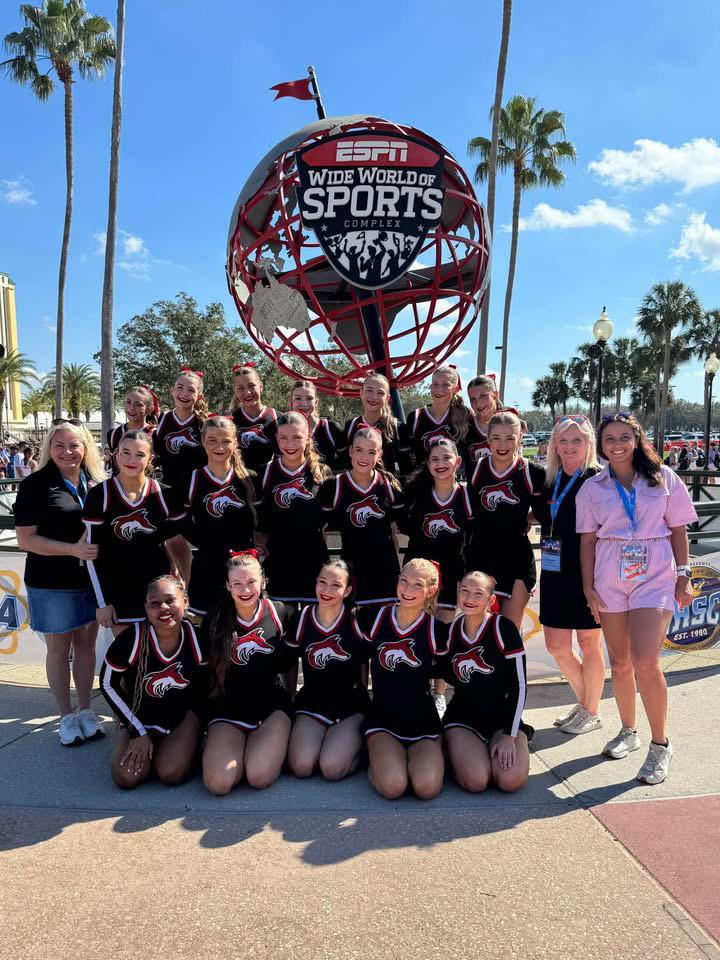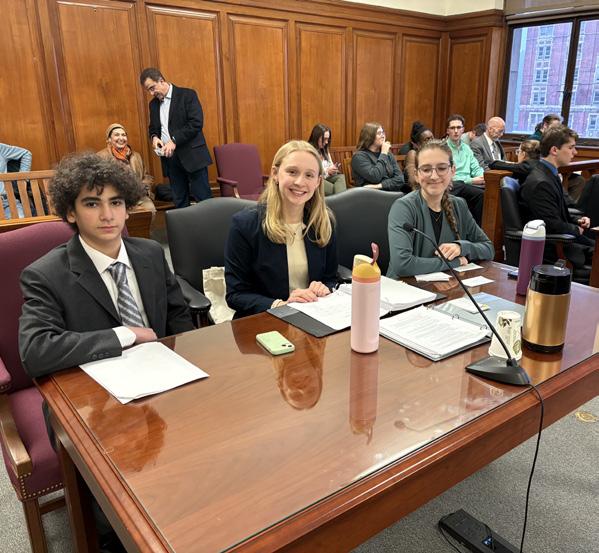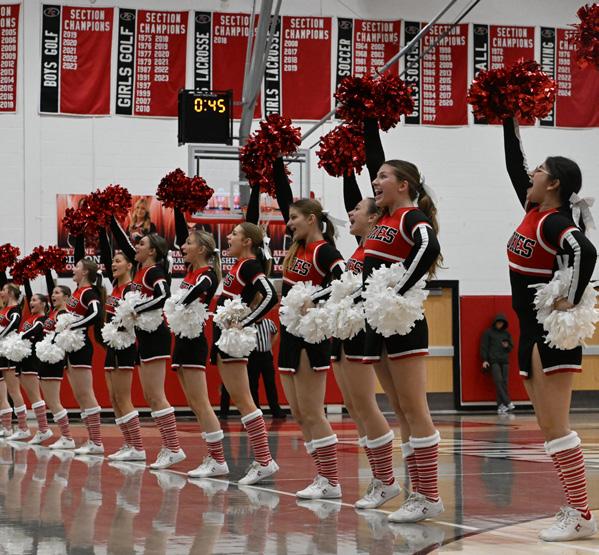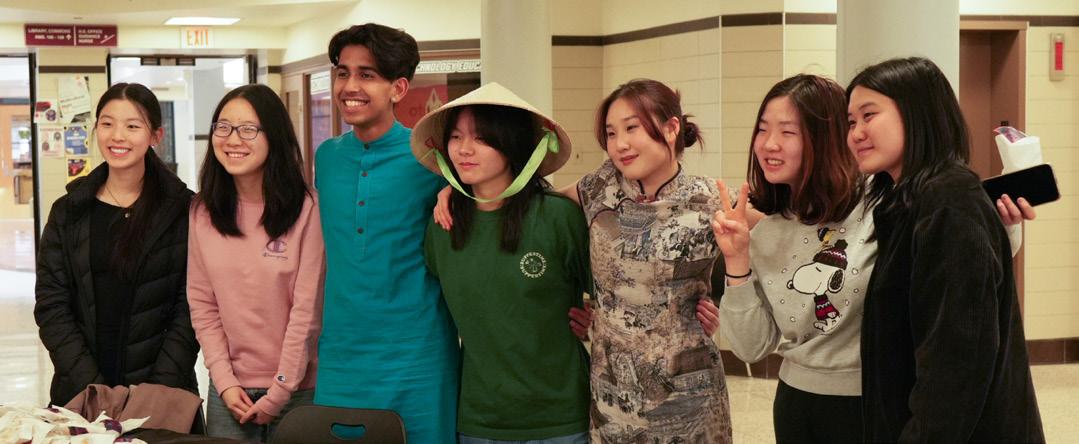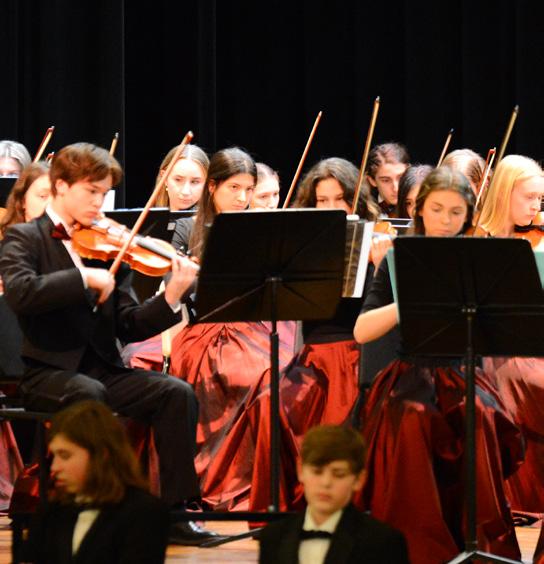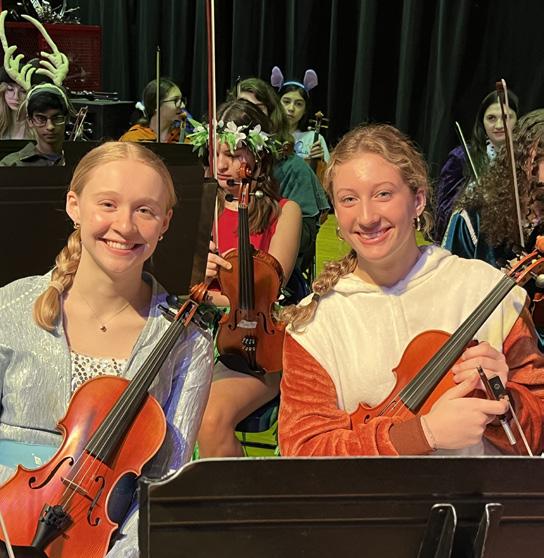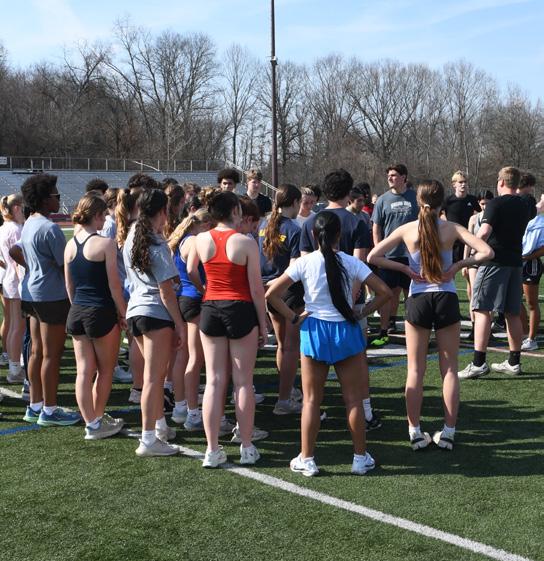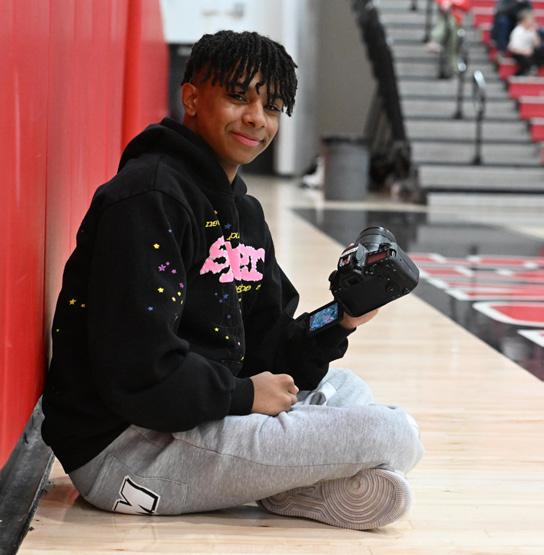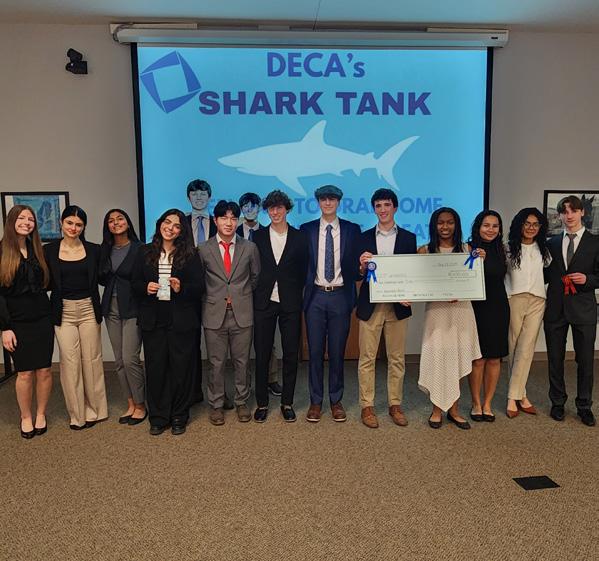

- Pg. 3 Boys Hoops Overcome Setbacks - Pg. 19 Mutlicultural Week - Pg. 13 Meet Dr. Smith - Pg. 6



- Pg. 3 Boys Hoops Overcome Setbacks - Pg. 19 Mutlicultural Week - Pg. 13 Meet Dr. Smith - Pg. 6
By Eloise Johnson
The Fox Chapel Area orchestra, band, and choir performed their biannual Kaleidoscope concert on February 23 at the Syria Shriners Center in Cheswick. Students from all music programs joined for the concert of non-stop music, which featured contemporary, jazz, and classical styles. The concert aimed to bring a variety of music genres to their audience, which amounted to over 800 people. Each piece was meant to be played one after the other with no audience applause in between, and with music groups performing all around the center, the audience was fully immersed in music for the entirety of the program.
pieces. The concert ended with a joint performance of Sogno di Volare by the orchestra, band, and choir. The piece was conducted by Mr. Murray, the choir director. Next year, instead of a spring Kaleidoscope concert, the music program will play its Major Works concert in the fall! It is sure to be a great performance!
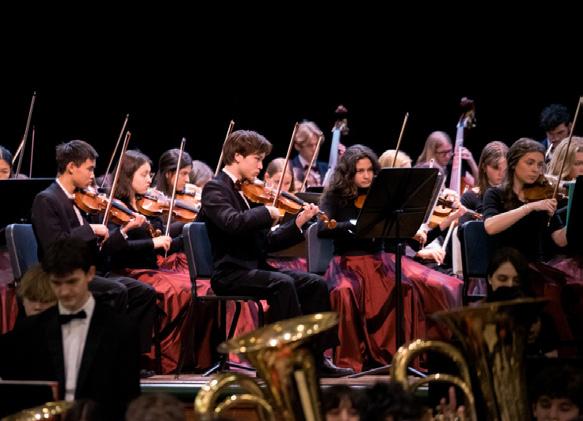

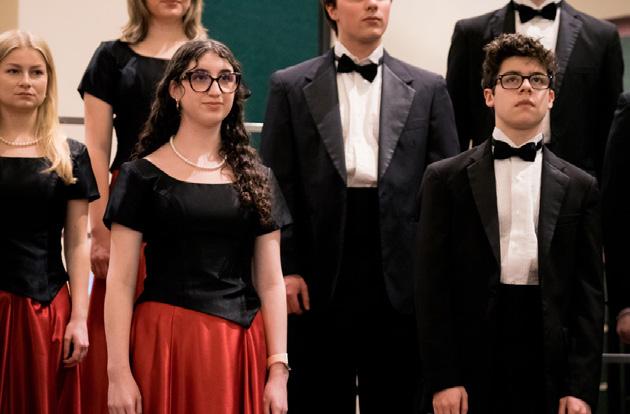
To begin the concert, Ms. Cooper, the orchestra conductor, led the band, orchestra, and choir in a performance of "Star Spangled Banner." Next, the orchestra and band immediately began their next piece, "Opening Night," which was conducted by Mr. Lesnik, the band director. The program continued with performances by the rock orchestra, jazz band, and various choir groups, including the Madrigals, Concert Choir, Men’s Ensemble, and Vulpes Cantantes. Pianists Caterina Wu, James Manges, and Ben Bliss also played during and in between
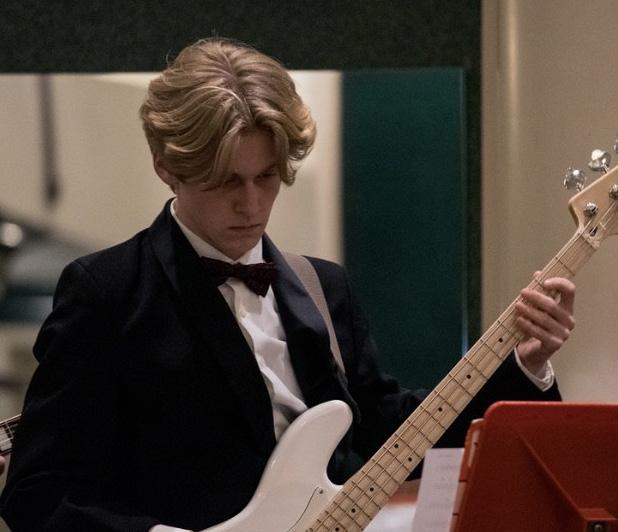

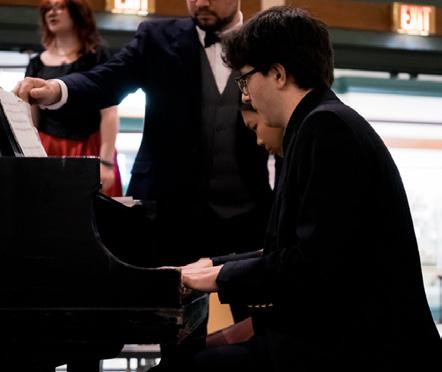
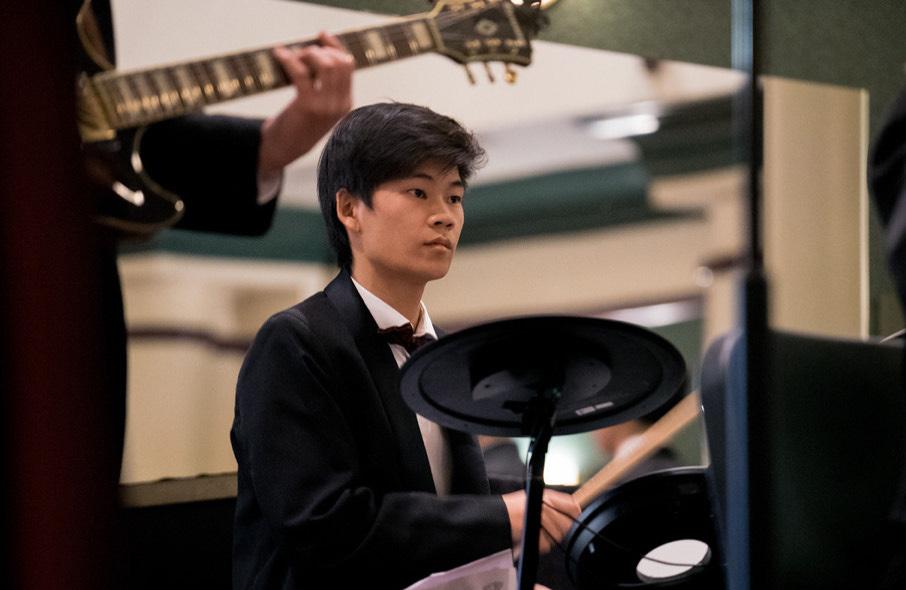
n March 5th, a large group of Fox Chapel students went to the Hillman Cancer Center Care on a field trip organized by Curing With CARE (Cancer Awareness and Research Education)! It was a valuable experience, teaching students about up-and-coming research and developments towards making strides in crushing cancer. The post-doctoral workers and oncology graduate students effectively simplifed complex and advanced concepts to make them comprehensible for the high school audience, and the presenters were extra passionate about their work — which I found very inspiring and hopeful. CARE’s mission is to cure cancer through increasing curiosity regarding awareness, research, and widespread education on the disease in hopes of eliminating the unfortunate reality that many have to face on a daily basis. This was an incredible way in which they increased audience awareness regarding how to care for those we know affected by cancer in an


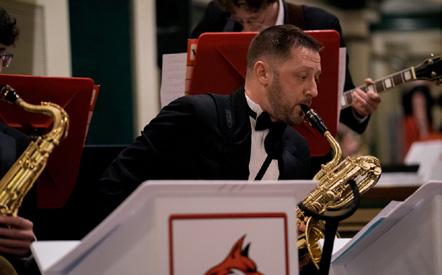

By Laila Golla
effective way, as well as increase our curiosity in brainstorming solutions. We toured around the Hillman Cancer Center as well, hearing from researchers regarding their current experiments and the objectives behind them. If you are interested in pursuing research or learning about physiological processes for the medical field, I highly recommend taking AP Biology with Mrs. Papariello — it has helped me comprehend so much more in the presentation and really understand why some things may help if they are resolved. CARE chapters are located in many different cities globally, and the organization is headquartered in Pittsburgh. If anyone is interested in starting a new chapter to make cancer care kits for patients in oncology wards and increase CARE’s mission, please reach out. I hope we can get a chapter started at Fox Chapel again next year! To learn more about this incredible organization, visit https:// curingwithcare.org!

group of Fox Chapel Area High School and Dorseyville Middle School students recently raised the most money in Pennsylvania for the 2025 Cool Schools Polar Plunge. The Fox Chapel Area team raised $44,807 to support the Fox Chapel Area School District Special Olympics Unified Sports teams and Unified Sports teams across Pennsylvania. The teams promote inclusion through competitive experience. This is the third consecutive year that the Fox Chapel Area team raised the most money out of all


The Best Buddies Club participated in the nationwide Special Olympics Polar Plunge. The Special Olympics organization has celebrated diversity and aimed to create a world of inclusion and since 1968. This annual event brings together all participating schools from around the Western Pennsylvania area! The Polar Plunge over 20 years ago in Rochester, New York! The first polar plunge had only 75 participants and raised $15,000, while this year 40 schools and 2,300 participants collectively raised over $1.2 million! FC’s Best Buddies chapter raised the most money with over $44,000! What makes the Polar Plunge so special is that with every $3,000 raised, a new unified sports team can be created at a high school. This means that schools without funding for Special Olympics can promote inclusion and receive support to create teams such as unified bocce, track, flag football, and soccer teams. Our school is so lucky to have multiple unified sports teams. Joining our unified sports teams (bocce, track, and flag

FBy Paige Solomon
the school teams in Pennsylvania. Over the past three years, the Fox Chapel Area Polar Plunge team raised $122,007. Donations can still be made to Fox Chapel Area’s team at https:// give.specialolympicspa.org/ team/619749. Additionally, once again, the Kramer Family matched a portion of every donation given to Fox Chapel Area’s team. Approximately 130 Fox Chapel Area High School and Dorseyville Middle School students participated in the Pittsburgh Cool Schools Polar Plunge on
football) is a great way to meet new friends, promote inclusion, and learn new skills. Look at the FC Athletics page for our unified track team’s schedule and sign up. Thank you to everyone who participated, donated, and supported our Best Buddies. The Best Buddies also hosted the Cupid Shuffle Dance in February. It was a big hit with 50+ people. There was a DJ, photo booth, snacks and drinks, and Valentine’s Day themed activities. All ticket proceeds went to our school’s Best Buddies Program’s funding. The event raised over $300! This has been a very successful and fun-filled year for our Best Buddies. Come support us at an upcoming Unified Track Meet!

ox Chapel Area High School’s literary magazine “Tapestry” was named a first-place winner in the 2024 American Scholastic Press Association’s Annual Contest/Review for Scholastic Yearbooks, Magazines, and Newspapers. The publication was one of 91 from across the nation to receive a first-place award. The contest is open to schools from across the country, including colleges and universities, and students compete against those in schools with similar enrollment numbers.
The 2023-2024 student staff members of “Tapestry” were 2024 graduates Caroline Berger (layout designer), Emma Bergerud, Mira Busch (layout designer), Laura Carter, Emmett Gillespie, Eileen Healy, Clara Kelley (editor in chief), Emma Kim, Madeleine Stone, and Isabella White; 2024-2025 senior Vie Filar; and 2024-2025 juniors Veda Catone, Nora Kelley, and Sophia Tai. The students’ advisor is Fox Chapel Area High School English teacher Jessica Green.

Hey Seniors! We are only a few months away from graduating and embarking on an entirely new chapter in our lives! It's time to take in every moment, and soak up the last few memories of high school. The Gratitude and Compassion Club is hyped to invite YOU to Senior Sunrise on May 2nd! It starts at 6:15 AM and concludes at the end of that Career QRT. Let’s start senior year together, full of energy, hope, and memories in the making. You don’t want to miss it!
What is a senior sunrise? Who can come? Senior sunrise is a way to celebrate the senior class by having everyone join together at the main stadium field to watch the sun rise! There will be breakfast, coffee, and cute photo ops. Any member of the senior class is invited, and it is free! Bring cameras, blankets, and tell your friends!
What is GCC?
Gratitude and Compassion Club is a club that celebrates all things kindness and giving back! We do crafts, hold fundraisers, and generally have fun finding ways to uplift our school community. We also celebrate GratiTuesday every week where we ask students and teachers what they’re grateful for to remind everyone that taking a moment to reflect on the good is a great way to take care
SBy Sienna Siegel
of yourself. Gratitude and Compassion Club was created two years ago because we noticed the school needed more activities based around kindness and acceptance. We thought it was a great way to bring more activities into our school, and give people more of a reason to join together. From making friendship bracelets and slime to creating and delivering Christmas cards to nursing homes, GCC loves to be creative and have a positive impact on our community!
Why did you start GCC?
We started GCC during our sophomore year. Having been at Fox Chapel for two years at that point, we’d had our fair share of experiences where we felt our school could benefit from more kindness in the air. Our goal was to create a club where anyone could feel comfortable just showing up, and where everyone would feel welcome, accepted, and valued. Spreading kindness has always been at the root of GCC, and we hope that mission can continue long after we graduate!
GCC Co-founders: Ainsley Anderson, Ava Persichetti, Janie Stone
GCC Treasurer: Luca Zgurzynski
ophomore Lilith Bohin was named a winner in the Prime Stage Theatre’s Fifth Annual High School Drama Awards. Lilith won in the best student costume design and/or fabrication category for Fox Chapel Area High School’s 2024 fall play, “Harvey.”
Other Fox Chapel Area High School nominees for the awards were senior Noah Miller in the best supporting actor category, and the team of senior Pauline Piechotta and juniors Molly Krajcovic and Adeline Moritz for best student makeup design and/or application.

Sophomore
According to the Drama Awards Director John Dolphin, “We could not be prouder of each and every one of the students who have dedicated themselves to producing some of the finest theatre we have seen … As leaders in the Pittsburgh theatre community, we feel it is our duty to bring guidance and recognition to the young
people who will soon take our place. They are the future of our community, both theatre and otherwise, and without them, Pittsburgh theatre would not be prospering in the amazing ways we see today.
The Prime Stage Theatre’s drama awards were presented at a ceremony that was held January 11, 2025, at The Hillman Center for Performing Arts. The awards recognize excellence in student-run high school drama and were open to schools from across Southwestern Pennsylvania.

By Eliana Wellman
Have you ever wondered what qualifies as art? Art varies from person to person. Everyone can have different interpretations of the same artwork. These interpretations can be based on personal experiences and beliefs. According to one American artist, Ed Ruscha, “Art has to be something that makes you scratch your head.” It has to make you think about it and ask questions.
The study of art and how to interpret it is called aesthetics. Aesthetics is a subset of philosophy that breaks down what counts as art was what does not count as art. It studies how and why artists create art, and how the audience reacts to the art. The reaction to art varies from person to person. This is due to a person’s experiences, beliefs, background, and general interests. People tend to have different viewpoints towards art due to these factors. Some of these are the artist’s intentions, and other times, they are not.
In many cases, an artist has a purpose or message that they are trying to share with the audience, and oftentimes, their artwork symbolizes something specific. This type of art is usually called representational art. It is the type of artwork that makes you analyze it and ask questions like “what was the specific purpose of this art?” and “what was the artist trying to explain?” Sometimes, this type of art reflects on a historical time period. For example, American Gothic, by Grant Wood, is an oil


painting of a farmer and his wife with stern expressions. When you apply the historical context, the painting represents farmers’ perseverance during the Great Depression. While some artists focus on historical paintings and drawings, others focus on illustrating a story.
Artwork that tells a story is called narrative art. This story could be mythology, a historical event, or a personal account. In some cases, it can also be seen as representational art if it has that aforementioned historical context. One example of this type of art is the The Scream, by Edvard Munch, which shows a person with their mouth wide open and hands covering their ears. It was based on a panic attack that Edvard Munch had walking on a bridge in 1892. Without knowing this information, the painting would likely be difficult to understand.
In summary, for proper understanding of art, an audience needs to be able to understand the backstory as well as the artist’s purpose for making the art.
Pittsburgh's very own Carnegie Museum of Art has a collection of over 34,000 works! They offer a FREE membership for all Pennsylvania teens (ages 1318). You can apply online here: https://carnegiemuseums.org/ join-support/membership/teenmembership/

By William Kelly
It is an exciting time at Fox Chapel as we welcome a new principal, Dr. Smith! Dr. Smith came to FC from the Northgate School District to replace Dr. McGee. With 21 years of experience in education, Dr. Smith has extensive knowledge about the high school environment, teaching, and administration. Dr. Smith is eager to connect with students, staff, and families. Do not hesitate to reach out to her with questions, concerns, or just warm, welcoming messages. Dr. Smith describes herself as tenacious, friendly, and sentimental. She grew up in Deer Lakes and attended Deer Lakes High School and holds degrees from Penn State University, Duquesne University, and Point Park University. Though her favorite subject in school was math, Dr. Smith ended up as an English teacher, which is a testament to her versatility and flexibility. Aside from her professional achievements, Dr. Smith likes to spend time
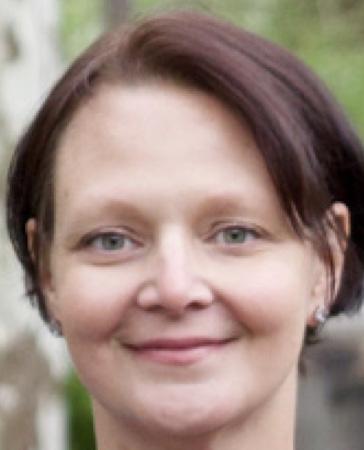
with her three sons, particularly at her favorite spot, the beach. Her two favorite places to go are Florida and the Outer Banks.
Although sunny weather is her preference, Dr. Smith also likes to ski. Dr. Smith is also excited to continue her rich involvement in school activities at all of our games and meets, having been on the softball, swim, and cheer teams during her own high school years. Dr. Smith came to Fox Chapel looking for more students to inspire and to continue developing her skills as a teacher and a leader. Dr. Smith’s favorite part about working with kids is that they are honest and genuine, and she enjoys being a part of their success. Her main goals for our school are to continue our lasting tradition of excellence and to offer support to anyone who needs it, mentally and generally. If you see Dr. Smith in the hallways, be sure to say "hello" and "welcome!"
By Rachel Pegher
Global Links is a Pittsburgh-based non profit that tirelessly works to improve the health and access to healthcare of communities with need. Local and global programs have been supported through this organization for more than 35 years. Specifically, they routinely work with the Pan American Health Organization/World Health Organization and the Ministries of Health to deliver aid and medical surplus supplies internationally.

a Pittsburghbased but internationally operating non-profit that provides humanitarian aid.
Our HOSA club (Health Occupations Students of America) coordinated with Global Links during the months of January and February, 2025. Fox Chapel Area High School’s lobby acted as a collection room for surplus medical supplies during these two months. Through Fox Chapel’s media pages and the help of Student Activities, people throughout our district were notified of our drive. Students were given one Fox Chapel or National Honor Society service hour for donating. Additionally, HOSA hosted a QRT competition from February 24th-28th. Congratulations to the orchestra QRT, which won with 28 items donated!
With all of its advertising, the medical supplies drive ended successfully. HOSA was able to gather over 2,900 medical items because of everyone’s united efforts. Our
collected items have an estimated worth of more than $600. Currently, Global Links is routinely providing aid to Bolivia, Cuba, Honduras, and Nicaragua.
HOSA sincerely thanks those who have helped this drive be a success.
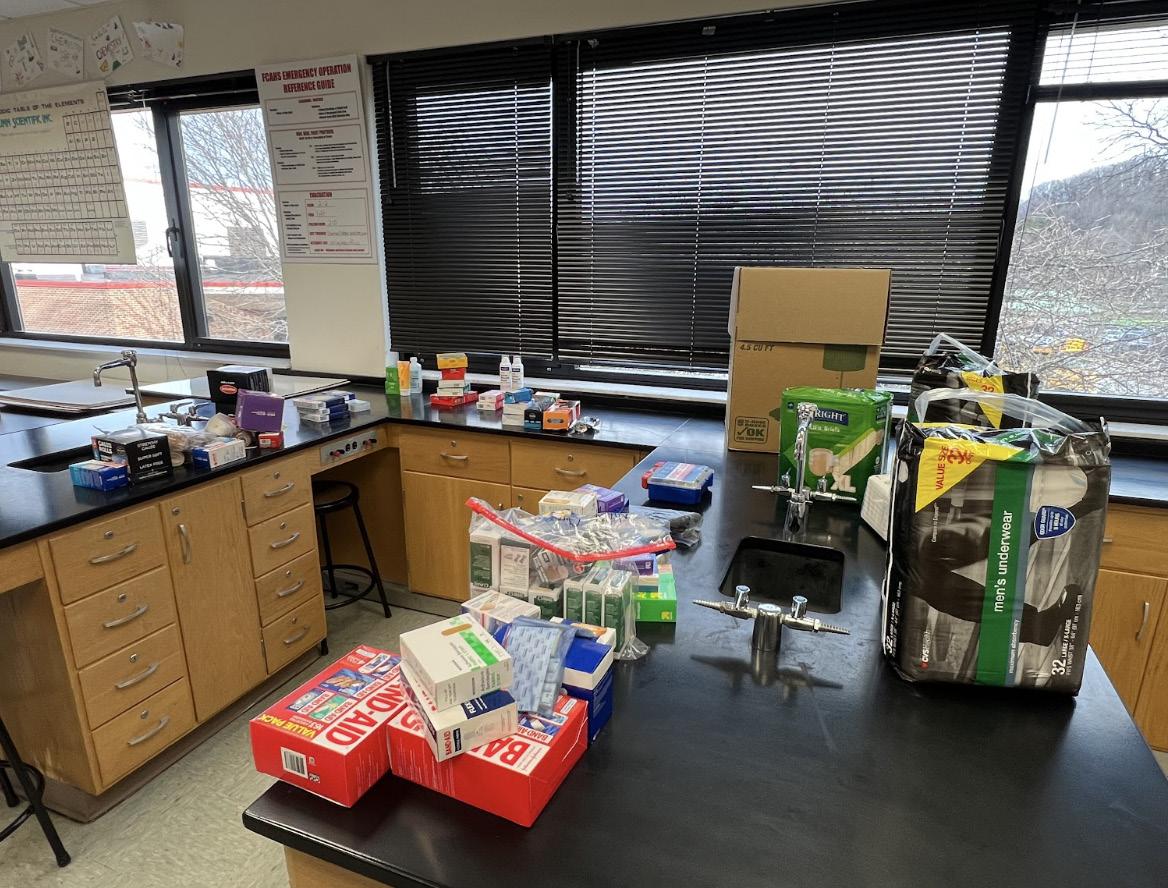



The way we power our lives is about to change forever. Clean energy has prioritized solar, wind, and hydroelectric power generation. However, a new source of energy is about to outshine these traditional, green energy sources. Fusion power is generated from light atoms colliding with each other and forming heavier atoms. Until recently, there was no economical way to control the high temperature plasma needed for this reaction but recent developments in superconductors have made this process significantly cheaper. Recently, two companies have announced purchase orders for fusion power plants by the early 2030s. Fusion power is a safe and clean form of energy production that recent, technological developments have made economically viable for commercialization.
Fusion power has been promised for decades, and the technology to make fusion reactions has been around for even longer. As mentioned above, until recently, there has been no way to make fusion power economically viable. Reactions required more power than they released and could not be run for a long period of time. Over the past few years, new developments in high temperature superconductors have brought discoveries of materials with critical temperatures above the boiling point of nitrogen, which allow for these high temperature superconductors to be cooled with liquid nitrogen as opposed to liquid hydrogen. Superconductors can generate magnetic fields vastly more powerful than rare earth magnets of the same size; however, they must be kept below their critical temperature to do so. High temperature superconductors have enabled the construction of fusion reactors capable of long-term operation without being prohibitively expensive to construct or operate.
Fusion is the process by which light atoms such as hydrogen and helium join together to form heavier atoms. This process releases large amounts of energy, as the mass of the final atom is lighter than the two original atoms. This difference in mass is converted into energy. In contrast to existing nuclear power plants, which can have disastrous malfunctions like the 1986 Chernobyl disaster, a fusion reactor cannot cause a disaster because fusion reactions occur under extreme heat, pressure, or a combination of the two. These conditions are naturally present in the core of a star. However, on Earth, the plasma (high temperature, ionized gas) has to be contained by powerful magnetic fields to maintain temperature and pressure. Without the magnetic fields, the plasma would rapidly cool as it comes into contact with the walls of the reactor. This contact ends the reaction. On an additional note, fusion reactions do not
By Ian Wellman
generate radioactive waste or harmful pollutants, unlike fission power plants and fossil fuel power plants. Instead, they produce helium as a product of the hydrogen fusion, which is harmless for the environment. Fusion reactors will be able to replace fossil fuels in energy generation in a way that other clean sources of energy cannot. Fusion power will allow for large-scale power generation without damaging our precious plant. The reaction rate can be adjusted to control the energy production, allowing for more power when there is a greater demand. Most current designs have the reactor running only part of the time, with some of the excess thermal energy being stored in heat sinks that can be used to generate energy while the reactor is not running.

There are many different organizations across the globe that are working to achieve commercially practical fusion power. The leading companies have already built and are testing large-scale prototypes before connecting to the electrical grid, including Commonwealth Fusion Systems, Helion, and Tokamak Energy, Inc. Tokamak Energy named themselves after the tokamak reactor, a device which uses a powerful magnetic field generated by external magnets to confine plasma in the shape of an axially symmetrical torus. All three of these companies are using different designs, but they all incorporate superconductors and heat sinks in those designs. Commonwealth Fusion and Helion are most likely going to be the first to reach commercial fusion power with their first, full-scale reactors, connecting to the electrical grid by the early 2030s. Commonwealth Fusion is using a more proven donut-shaped tokamak, while Tokamak Energy is using a spherical tokamak that has the potential to be more efficient. Unlike Commonwealth Fusion and Tokamak Energy, Helion is using magneto-inertial fusion reactors. All of these reactors use hydrogen and helium isotopes for fuel.
A world powered by fusion is imminent. Both Helion and Commonwealth Fusion Systems have received purchase orders for their reactors. This means that both companies and their customers have enough confidence in their designs to promise a fusion reactor connected to the electrical grid within the next few years. These developments in commercial fusion power represent the beginning of a new era of cheap, clean energy production, one that could last hundreds of years.
By Sabina Mantella
On February 12th, Fox Chapel Area High School hosted one of its many blood drives in partnership with Vitalant. Students over 16 years old, under the consent of a guardian, had the opportunity to donate blood in the LGI between QRT and third period. Participants were reminded to stay hydrated while maintaining a proper diet in the days leading up to donation. The prerequisites included a consent form, a questionnaire, iron testing, and blood pressure testing. On the day of the donation, students were given a Gatorade drink and a variety of snacks and refreshments afterwards. Students were guided throughout the process in a supportive environment. School counselor Ms. Machen and student volunteers remained in the LGI, helping those feeling uneasy. These blood drives are just one, but incredibly important way in which our district aids the community.
donation rates being the lowest in decades. For over 80 years, Vitalant has worked in pursuit to offer a safe blood supply to over 900 hospitals. Through Vitalant and Fox Chapel Area School District's partnership, 73 students, teachers, and commuity members donated in one day! A singular donation has the possibility of saving up to three lives. Thank you to all who participated in the blood drive! Your efforts allow for the district to make a lasting difference for those in need.

with the school district to organize blood drives.
The Red Cross reports that every two seconds an American needs blood, whether that be for surgery, traumatic injuries, or cancer treatment. That accounts for over five million Americans today, yet unfortunately there has been an emergency blood shortage with
EThe ongoing blood shortage in America can be attributed to numerous issues. Firstly, older donors are passing away or retiring with less youth filling the role. Even more damaging for blood donations was Covid-19. When quarantine began, regular donors were taken off of their schedule, with less returning when protocols were lifted. Additionally, many blood drives were employerbased, but when remote employment became more readily available, these donations became less frequent. Although one drive may not remedy the ongoing blood shortage ravaging our nation, Fox Chapel Area High School's small part helps address a national issue and hopefully produces a handful of regular donors.
ight Fox Chapel Area High School and A.W. Beattie Career Center students have been inducted into the National Technical Honor Society (NTHS) this year. Seniors Derrick Clements, Brianna Hnatow, Cecily Sarra, Gretchen Shelestak, and Nathan Yeske; and juniors Jackson Biehl, Casey Byrne, and Gracen Patterson were inducted into the NTHS at a ceremony on March 4, 2025, at A.W. Beattie Career Center.


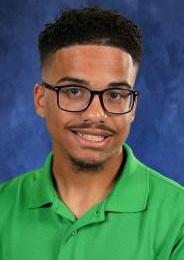
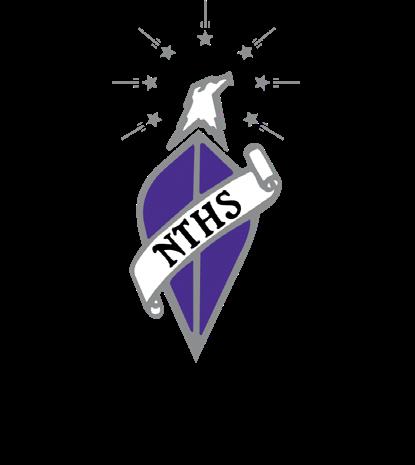
To be considered for the honor, students must maintain a grade point average of 3.0 or higher on a 4.0 scale, have a grade of at least 95% in their career training program, and miss no more than five days of school. Candidates also must have a clear disciplinary record and belong to a service organization or participate in an extracurricular activity. Congratulations the honorees!





The first day at a new job is usually about learning the ropes, but for Dr. McGee, it was a test of leadership right from the start. A disciplinary situation arose from the prior year, and despite having little context, he stepped in with the grace, authority, and compassion that would define his time here at Fox Chapel Area High School. It was clear from that moment that we had gained not just a principal, but a leader who truly cared.

Through his time, he was faced with countless challenges. Student behavior was an issue during the beginning of his time, and COVID posed a great challenge to the entire school. It was through these challenges that a community emerged, with relationships being strengthened between teachers and students, and Dr. McGee hopes that after his departure, Fox Chapel continues to strengthen this community, which he believes is second to none. He commends the administrative staff in all their efforts in creating a nurturing environment filled with support that is nothing like he’s ever seen before. He experienced this firsthand with the immense amount of support he felt from the staff and students after speaking about his son's accident. The connection he felt was so special and the support offered to him at this difficult time was amazing. Dr. McGee would like to tell everyone, to "Persevere until you succeed. Life will always throw curveballs at you, you will get knocked down, but the more that you can rely on yourselves and the support systems that exist around you, the better off you will be to develop your skills and be successful."
The most enduring quality of Dr. McGee is his unwavering dedication and love of the students here at
Eight Fox Chapel Area High School and Dorseyville Middle School students won awards as part of the 2025 Region 7 Meeting of the Pennsylvania Junior Academy of Science (PJAS). All eight students qualified for the state competition. Fox Chapel Area first-place winners were seniors Omar Al-Bataineh, Anna Delale-O’Connor, Etash Jhanji, and Rohit Velankar; sophomores Heidi Stiger, Param Thawani, and Rachel Kim; and eighth-grader Rishabh Krishnamurthy. The state PJAS competition will be held May 18-20, 2025, at Penn State University, Main Campus.

By Prachi Behal
Fox Chapel. Through his years of experience with children, he learned that, "you have two ears, two eyes and one mouth for a reason. You have to observe and listen to what's going around you before speaking." He also learned that when looking at teenagers, you can’t look at who they are right now, but rather who they are going to become.
The most rewarding part of his experience at Fox Chapel has been watching students' transformations — watching them evolve from immature ninth graders to exemplary, refined seniors. That being said, the thing which he will miss most about Fox Chapel are the students who have left such a lasting legacy on him and serve as one of the things he wishes he could take with him.
Dr. McGee hopes that students remember him as someone who was in the trenches with them, and that he always looked out for them to maximize their potential and become successful. With this, he would like to extend to students that he does have a social media presence and if anyone ever needs something, they should not hesitate and reach out — there is never a time where he will not help a student. One final message he would like to leave with the students is that "you have the world at your feet. Your story isn't written yet, so make it a bestseller." He would also like to leave with the teachers' word of admiration for all their hard work in creating such a supportive environment, and encouragement to continue all the great work they are doing.
Though we say goodbye, the legacy of Dr. McGee will always remain in the heart of Fox Chapel. Thank you for everything from all of us in the Fox Chapel Area High School community.
Four Fox Chapel Area High School students were selected to perform with the Pennsylvania Music Educators Association (PMEA) District 1 Choir. The students are seniors Alaina OKunewick and Mya Wilson, junior Robert Svenson, and sophomore Evangeline Sereno.
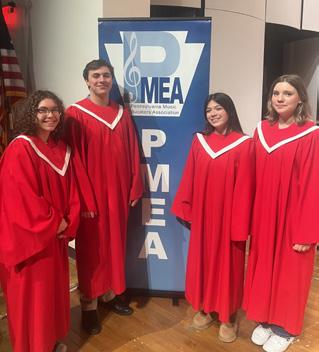
The choir featured students from Allegheny, Fayette, Greene, Washington, and Westmoreland counties and the festival was held at Mount Lebanon High School February 6 and 7. It culminated in a concert directed by Dr. Amy Voorhees, the director of choral activities at Susquehanna University.
By Vesta Homayoun
On January 16th, a group of Fox Chapel Area High School students stepped into the world of cardiovascular surgery, witnessing an open-heart procedure firsthand. This opportunity, open to juniors and seniors with aspirations in the medical field, provided a front-row seat to one of the most intricate and lifesaving procedures in modern medicine.
The students were in an observation deck above the operating room, where they had a clear view of the entire intricate operation. They could view the whole surgical team as well as the surgery taking place below them. The operation involved the repair and replacement of three crucial heart valves, including the tricuspid and mitral valves. Under the surgical lightheads, the medical team worked with precision and skill, replacing one valve entirely while repairing the others. With the patient’s heart temporarily supported by a heart-lung machine, the surgeons stitched, adjusted, and tested each repair with amazing dexterity. Students observed how every movement in the operating room had a purpose, from the careful coordination between the lead surgeon and assisting staff to the seamless communication ensuring the patient’s stability.
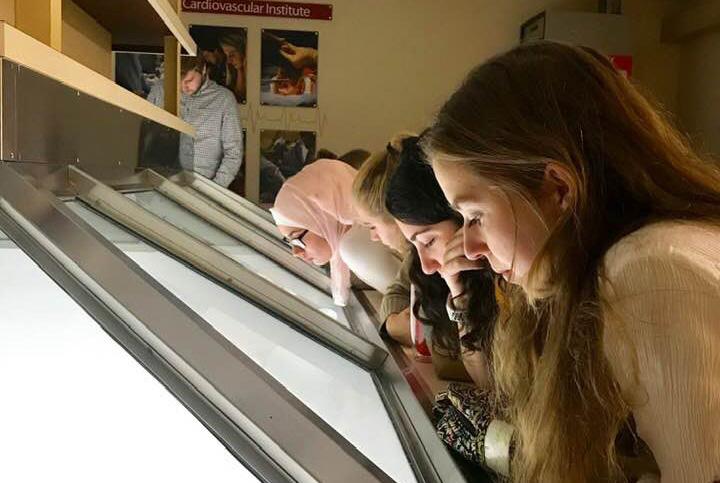
the complexities of cardiac surgery. The students learned about the importance of maintaining blood circulation, how the heart-lung machine functions, and the delicate balance required to guarantee the patient’s safety. For aspiring medical professionals, this experience was eye-opening. Watching a real surgery unfold reinforced the immense responsibility that comes with working in healthcare, but it also enabled fascination. It was more than just technique—it was teamwork, quick decision-making, and unwavering focus. Seeing these elements come together in real time can leave students with a greater appreciation for the field and a deeper motivation to pursue their own medical ambitions. However, observing an open-heart procedure firsthand can also provide a glimpse into the intense, high-pressure environment of the operating room.
Observations like these bridge the gap between classroom learning and real-world application, offering a rare glimpse into the realities of medicine. Whether these students go on to become doctors, nurses, or researchers, one thing is certain — the firsthand experience of witnessing a beating heart being mended will stay with them.
Throughout the procedure, a surgical technician explained each step to the students, offering insight into


Fox Chapel Area High School junior Karsten

Buchert was named a national winner in the Congressional Essay Contest for high school students run by the National Society of the Colonial Dames of America (NSCDA). Karsten is one of approximately 50 winners from across the nation and one of only three from Pennsylvania. The essay topic was “Explain whether existing defamation and libel laws are or are not sufficient to prohibit baseless AI generated and distributed content.”
As a national winner, Karsten will receive a full scholarship to attend the highly interactive and civicsfocused Workshop Foundation’s 49th Congressional Seminar in Washington, D.C. There, Karsten will join
other winning students from across the United States in a model congress activity and will also meet leaders from both the federal government and private sectors. Additionally, the national winners will tour the White House, congressional offices, historical landmarks, and museums. The seminar will be held June 23-27, 2025.

Founded in 1891, the NSCDA is committed to the exploration and interpretation of this country’s complex history. Across 43 states and the District of Columbia, the NSCDA’s members are stewards of history, women of action in their communities, and champions of the nation’s ongoing story. The society headquarters are located in Washington, D.C.
By Laila Golla
On Tuesday, February 25th, nine students (Karsten Buchert, Alana Calig, Sera Filar, Noelle Fouron, Laila Golla, Priscilia Hayetian, Eloise Johnson, Sabina Mantella, and Zehra Ozkaya) attended the World Affairs Institute of Pittsburgh at Carnegie Mellon University. I had the privilege to be one of these students, and it was super interesting to learn more about how to make Pittsburgh into a global city — which was this year’s theme. The day consisted of delicious meals, a moving poetry performance by City of Asylum writer Rania Mamoun, and three panel discussions — each with slightly different topics. In between the panels was a multilingual musical performance, which captured everyone’s attention and was both interesting and engaging. To me, the panels were the most important in helping to understand methods to globalize Pittsburgh, and how these could translate to a better city for all.

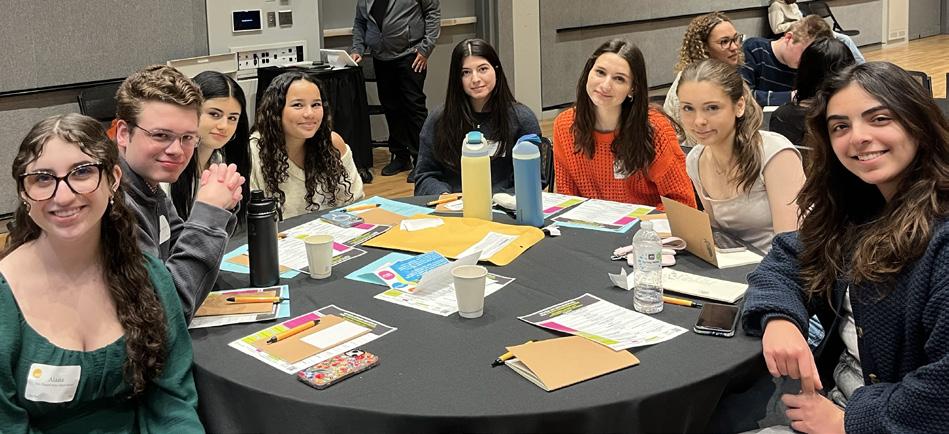
to move to less developed neighborhoods without access to affordable housing elsewhere. He created and implemented the Allegheny County Community Violence Reduction Initiative, and urged us to always consider the impact of actions on those that may currently be suppressed or neglected in decision making. He shared that before Pittsburgh can look to be a global city that competes with Los Angeles, New York, and famous cities abroad, it must care for its own residents — something currently not done to the fullest possible extent.

The diverse group of panelists gave valuable insights about what they have learned from their experiences in Pittsburgh, including Allegheny County Executive Sara Innamorato. She provided her perspective and role as a government official, and how she is dedicated towards taking steps for making Pittsburgh more inclusive and global. To her, a global city meant integration into communities, and she shared the importance of inclusivity and offering a welcoming city towards immigrants and refugees. Dr. Kendra Ross of Duolingo, another panelist, provided us with knowledge about the role of companies in making Pittsburgh more global and inclusive, and she highlighted the diversity in socioeconomic status in Pittsburgh currently — with some neighborhoods lacking access to resources that could enable their success.
In a later panel, Nick Cotter, a research practitioner with the Allegheny County of Human Services, emphasized the correlation between communities in poverty and increased violence due to deindustrialization — displacing many from their homes and forcing them
Another interesting topic that the last panel focused on was the importance of young talent attraction and retention for Pittsburgh. Eric McAllister discussed the immense opportunity available in Pittsburgh for establishing careers and getting support from others — including the networking available to become an entrepreneur that creates their own job to better suit them and their talents. Saleem Ghubril of the Pittsburgh Project shared the incredible generosity of Pittsburgh community members towards helping each other, as well as the education opportunities that are plentiful in Pittsburgh for youth. He is passionate about expanding education, and also emphasizes the unusually accessible education available for many in Pittsburgh, which contributes to the success of future generations. The panel revolved around utilizing this young talent in the workforce back in Pittsburgh to help advance it as a global city — something that requires youth awareness of the workforce opportunities here as well. They provided us with insight about some of the workforce availability and prosperity, and also urged us to give back to Pittsburgh in order to retain the talent yielded from the youth investment in Pittsburgh. Overall, the day was very meaningful, and I feel each of the students in attendance gained new awareness of issues or future pursuits they may want to undertake.
Irecently had the pleasure of attending the 54th Annual World Affairs Institute organized by the World Affairs Council of Pittsburgh. This year’s topic was “Making Pittsburgh a Global City.” Panel discussions covered a variety of issues, many of which I found quite insightful such as talk on our area's cultural vibrance; however, I feel some of the viewpoints expressed on the economic side missed the mark. Ideas were thrown around of letting small businesses drive our economic growth, investing locally, and extending beyond plainly attempting to become a tourist destination. While these are commendable goals, this simply is not the way to go if we want to achieve recognized status on the international playing field.
When “global city” is mentioned, there are a few places that immediately come to mind e.g. New York City, Tokyo, and Shanghai. What do these have in common? They are financial powerhouses being dominated by the service sector as well as all having their own stock exchanges. They are hubs for trading, educated workers, and private industry. Furthermore, the corporations that thrive there have invested far beyond their city limits. The automakers based in Tokyo are a great example. This includes Toyota. The third best-selling car in the United States and seventh best-selling in Europe for 2024 were Toyotas. How has this expansion benefited Tokyo? Over 5 million people in the area are employed in the automotive industry with labor demand existing for both skilled and unskilled workers. A vast range of human capital is needed from knowledge of truck driving to engineering credentials. This is a possible factor that leads to a lower gini coefficient of income inequality in Japan compared to Pittsburgh’s gini coefficient alone which was point two higher than Japan. This indicates more income inequality and a less sustainable labor market. The benefits also exist in the countries these companies have expanded to. For example, in the United States, Japanese automakers provide 1.6 million jobs. Small businesses are not capable of generating such a labor demand as they typically are not firms of scale nor do they garner global support. While they may benefit from being situated near a financial center, they certainly won’t drive the growth of it. Small businesses majorly contribute to Pittsburgh’s cultural identity; restaurants can be found representing virtually every nationality of immigrant, but we cannot rely on them to be a contributor to our global economic influence. They also struggle to pay competitive wages that large companies can comfortably offer, which are generally more appealing to prospective employees. Now, those aforementioned cities are absolute metropolises, so it
By Karsten Buchert
may be a bit unfair to put them next to Pittsburgh, small in comparison. But good news: Pittsburgh could ascend to their level! It is already home to nine U.S. Fortune 500 companies and is becoming a center of education and healthcare. With 29 institutions of higher education in the area, we have the capacity to churn out hundreds of educated workers. The key for globally-recognizable economic growth is to harness that human capital by having well-paying, large corporation-provided jobs available. Preferably, resources should mainly be maximized by those already nationally ranked firms.
The Steel City has historically been upheld by a big business, leaning on the private steel and coal industries for years. Pittsburgh even had its own stock exchange that operated for 80 years, 1894-1974. When the steel industry lost its wind circa 1970 due the growth of production elsewhere, the local economic prosperity went with it and thus so did that stock exchange. Our region needs a “new steel.” There are many existing options, private healthcare, software, or fracking for oil and natural gas. Major companies in the area are already engaging in successful international operations spreading the Pittsburgh name such as healthcare conglomerate UPMC. The University of Pittsburgh affiliated company operates facilities in Italy, Ireland, and Croatia. It is also collaborating with Nazarbayev University in Kazakhstan to create the first “international academic medical center.”
In terms of tourism, Pittsburgh is also in an excellent position. We have a lot going for us to attract visitors: nationally recognized museums, three national-league sports teams, a growing gambling industry, historic theme park, scenic locations, and so much more. Despite not having the pop-culture draw of a city like Los Angeles or New York, Pittsburgh is affordable for visitors, has offerings for all ages to enjoy, and is marketable to a diverse group of consumers. Love hiking? There’s hills everywhere. Love kayaking? Check out our three rivers. Unlike ahem… Cleveland, they’ve never caught on fire. You get the point. Notably, revenue from the arts has been growing. Between June 2022 and June 2023, the arts brought in $1.6 billion dollars. Art work is a valuable resource for promoting cities. Case and point: Chicago, Illinois. One of its main tourist attractions is literally a giant, shiny, bean-shaped sculpture. I can’t say I fully understand it and definitely don’t envy whoever has to clean it, but it contributes to the city being distinct and known. In summary, with large private firms, backing from their international investments, employment of a skilled labor force, and tourism, Pittsburgh will be on its way to becoming a global player.

By Zehra Ozkaya
The week of March 17th was multicultural week at Fox Chapel, and the diversity of our community was put on full display. Clubs got together and sold ethnic foods during the lunch periods throughout the week, providing a taste for our students from a variety of different areas of the world. Then, on March 19, Multicultural Night, the main event of the multicultural week, was held at Fox Chapel Area High School where students and teachers helped put on a remarkable performance and booth event.

A variety of different clubs helped to make this week a success. The Diversity Council and Desi Club were the leading student organizations who collaborated to orchestrate the event and the concert. At the beginning of the night, clubs set up booths in the cafeteria decorated with decorations that represented the clubs the best. Samples of foods were placed out for people to take as they wish as they pursued the elaborate set up. Clubs like Asian Cultural Club, Spanish Club, and Latinx Heritage Club were among the several clubs who contributed to the success of the night.
After about an hour of moving from booth to booth, gathering samples, and learning more about each of Fox Chapel’s diverse club offerings, attendees moved into the auditorium for the performance section of the night. Several students partnered up to put on a performance representing their abilities in cultural dance and song. The faculty also had a major contribution to this portion of the night
as school counselor Mrs. Machen, science teacher Mrs. Butkovic, social studies teachers Mr. Rios and Ms. Meder, and English teachers Mrs. Polsiak and Mrs. Green took the stage at the beginning of the performance to kick it off with a well rehearsed dance, choreographed by Desi Club president, Arnim Kuchal.
The performance went on to show off the skills of Desi Club, the Black Student Union, and many other performers from several of the clubs that contributed to the week. The audience saw a line dance from students including Tyanna Binion and Gabrielle Generett as well as a Wushu performance from Ryan Wang, Matthew Wang, and Bryce Jones. Each of these students and many more showed off their cultures and connected with each other on stage as they danced to efficacious music or performed a popular art style that most of the audience had never seen before. The audience was introduced to the world in one night as representation from a variety of different countries were showcased through music, dance, and food immersing them in diversity.

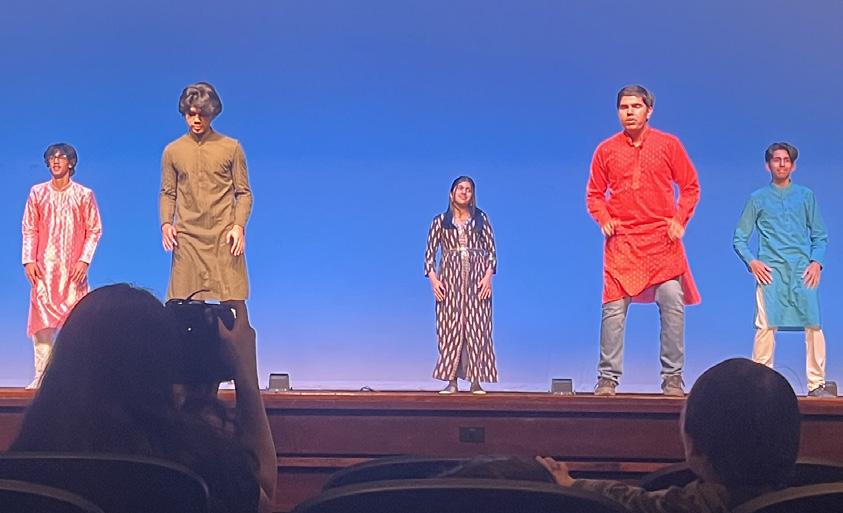

Multicultural week not only displayed the immense cultural heterogeneity in our community, but also brought donations to Fox Families Care. Fox Families Care is a local charity organization that is dedicated to bringing attention to those in our community who need financial assistance and are no longer able to receive aid from the government.
Donations are very much appreciated and efforts to assist the many families in our community who need it will continue.
By Arman Alborzi
In 2025, brought on with President Donald Trump’s second term, the U.S. has reignited trade conflicts with key global partners, imposing tariffs on Canada, Mexico, and China. The administration has claimed that these measures will protect American industries. However, these tariffs have unexpectedly triggered stock market volatility, increased investor uncertainty, and caused disruptions across multiple sectors, contrary to the intended protective effect. The abrupt nature of these trade policies is rattling Wall Street. In March 2025, the S&P 500 suffered a ten percent correction, erasing four trillion dollars in market value. The Dow Jones experienced sharp declines as investors reacted to escalating tariffs and retaliatory measures from China. Many are shifting toward safer assets like bonds and gold, while others are hesitating to invest, fearing prolonged instability.

demand from non-tariffed markets.
Corporate earnings have reflected these struggles.
Caterpillar and Boeing are reporting lower revenues, citing weaker global demand. Small businesses, too, are feeling the pressure. The National Federation of Independent Business noted declining confidence, as owners fear rising costs and unstable trade policies. Major corporations like Delta and Walmart have revised their growth forecasts downward, attributing the slowdown to shaken consumer confidence.
The trade war’s effects have varied across industries. Retail giants like Walmart and Home Depot are struggling with rising costs due to tariffs on Chinese goods. Some companies are seeking alternative suppliers in Vietnam and India, while others have passed increased costs onto consumers, fueling cost-push inflation. Automakers, including Ford and General Motors, are faced with higher prices for imported components, forcing them to raise vehicle prices and leading to weakened demand. The technology sector has also taken a hit. Apple, heavily reliant on Chinese manufacturing, is reconsidering its supply chain, while Boeing has seen reduced demand from Chinese buyers due to retaliatory tariffs.

The agriculture sector is suffering as China and other countries have imposed retaliatory tariffs on American exports, reducing demand for U.S. soybeans, corn, and pork. Small businesses, mainly those reliant on imported goods, now face higher costs and supply chain disruptions, making it harder to stay competitive. The shipping industry is experiencing declining freight volumes as global trade slows down, in-turn hurting major ports. Meanwhile, the energy sector has seen mixed effects: domestic steel tariffs raised costs for pipeline construction, and oil and gas exports benefited from shifting trade dynamics as well as increased
The trade war is also disrupting currency markets, causing fluctuations in the U.S. dollar as investors react to the uncertainty of long-term economic consequences. Concerns over potential trade imbalances and shifts in global economic power have contributed to this volatility. Currencies from countries affected by tariffs, including the Canadian dollar and Mexican peso, have experienced volatility. In response, the Federal Reserve is cutting interest rates to counteract economic slowdowns. While this provides short-term relief, it also signals economic fragility, keeping investors cautious. Even after the immediate tariff battles, the effects of Trump’s trade war are expected to linger, with ongoing supply chain restructuring and continued market volatility as businesses adapt to new trade realities.
Businesses are continuing to restructure supply chains to mitigate geopolitical risks, though this transition is costly.
Uncertainty over future trade policies remains a concern, with the aforementioned market volatility being likely to persist. Additionally, the trade war has strained diplomatic relations with key allies and trading partners, complicating future negotiations.
Though Trump’s policies had originally aimed to bolster American industry, they have instead created a climate of economic instability that has rocked financial markets. The stock market is facing sharp fluctuations, and industries are struggling with rising costs, and businesses now have to navigate unpredictable trade policies. Even beyond Trump’s presidency, his trade war will surely disrupt global commerce for years to come.
By Karsten Buchert
Everyday except Sunday and federal holidays, mail is delivered across the country by the United States Postal Service. While it may not be the first government entity you think of, this public service has a storied history, having existed since before the 13 colonies even declared independence from Britain. In 1775, after the Battles of Lexington and Concord, the Second Continental Congress, in their process of planning a new government, disavowed the colonial post system and appointed Benjamin Franklin as the new Postmaster General. An effective post service was essential to the revolution effort since communication on the yankee side needed to pass under the nose of the British. Franklin was ideal for the position; he had previously served as the Postmaster General of the Parliamentary Post alongside Deputy Postmaster General William Hunter. Franklin was dismissed from this job though by the British in 1774 following the Hutchinson Affair, which was an interesting incident in itself. Essentially, Franklin received letters by the Governor of Massachusetts, Thomas Hutchinson, to the British Crown that requested more troops be sent to the colonies with the intent of suppressing growing rebellion. Originally, Franklin had wished for the letters to be circulated with his colleagues in secret, however John Adams published them in a Boston newspaper. After three innocent men were accused of leaking the letters, Franklin came clean and admitted to his interception of the documents. The Crown’s replacement was devout loyalist Hugh Finlay who had an underwhelming tenure as the Parliamentary Post shut down by Christmas of 1775 due to demonstrations from colonists and competition with the new system organized by the Continental Congress.
During the Revolutionary War, the new postal system primarily handled military and diplomatic correspondence instead of civilian mail. Franklin only oversaw this effort for a short time, leaving in 1776 to famously become the ambassador to France. The Articles of Confederation provided Congress with the authority “to establish post offices and post roads.” With the adoption of the Constitution, Congress retained this power. In 1792, the Postal Office Act was passed which officialized Congressional power over a national public postal service. Notably, it also forbade the opening of letters for surveillance purposes and allowed newspapers to be distributed through the mail at extremely reduced rates. Throughout the 1800s, as the United States expanded, the postal system went with it; post offices were established in new territories and states. The Pony Express began in 1860 to cover the land that railroads had yet to reach with dedicated horse-riding mailmen
being able to trek 1,800 miles from the gateway to the West in Missouri to Sacramento, California in just ten days. What is commonly overlooked about the Pony Express though is that financially, it was an utter failure. Because it never managed to secure a contract for any government funding, the service made virtually no profit. It was ultimately “outrun” by telegraph wires shutting down after only 18 months in operation.
1847 marked a key development in the history of the United States Postal Service: the introduction of stamps. With these first stamps, fittingly featuring Benjamin Franklin (5 cents) and George Washington (10 cents), those sending out mail could now pay the rates in advance and have their outgoing mail collected directly from their residence. This also marked the growth of philately, the collecting of stamps, as a hobby in the United States. Some even call the late 19th century the “Golden Age of Philately” for the United States. In 1902, following an 1896 pilot program with five routes in West Virginia, USPS made Rural Free Delivery an official service. This program, which still exists today, allowed for mail to be delivered directly to remote communities and citizens instead of the said remotely located having to travel long distances to pick up mail themselves or pay a middleman to carry it the last mile. As of 2022, the Postal Service served approximately 80,000 rural mail routes.
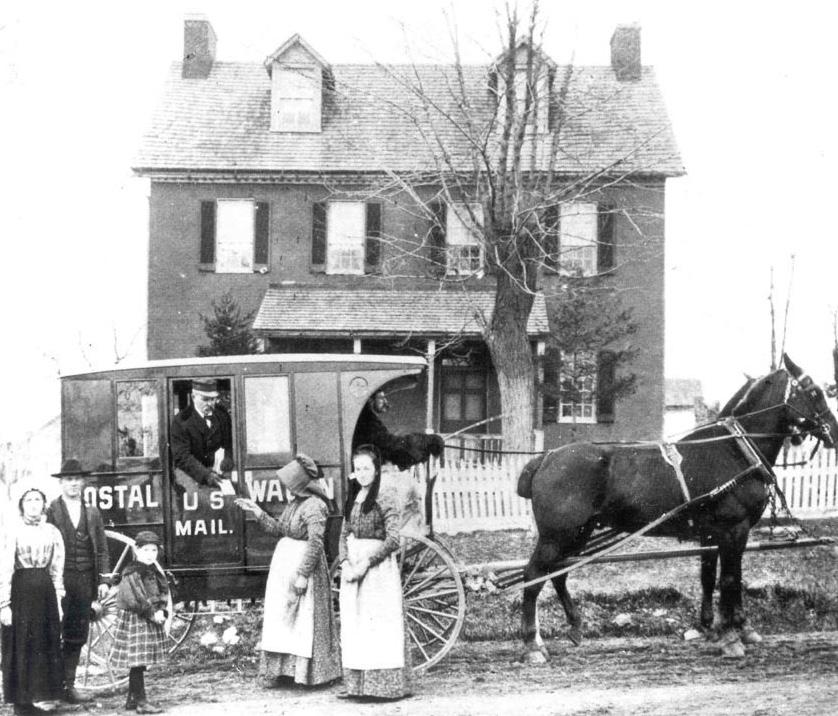
1913 saw the introduction of parcel shipping into the services offered by the USPS. You now weren’t just limited to letters, you could mail basically anything, including human children! In January, the first month the parcel service started being offered, couple Mr. and Mrs. Jesse Beauge of Glen Este, Ohio paid 15 cents in stamps and $50 of insurance to have their son mailed about five miles to Batavia, Ohio. Perhaps the most well-known instance of mailing children in the United States is the case of five year old May Pierstorff. The children’s book Mailing May is based on her 73 mile journey between two towns in Idaho which prompted regulations to be imposed on shipping children with the phenomenon widely fading away by the end of 1915. But speaking of regulating the mail, let’s digress from the main branch of the Postal Service and highlight their other arm, the United Postal Inspection Service. Contending with the
U.S. Marshal Service for the title of “oldest federal law enforcement agency,” postal inspectors are federal agents responsible for protecting the mail, which might sound underwhelming, but it is actually a very important job. The agency works to stop package theft including “porch pirating,” the distribution of narcotics, identity theft, scams that are transmitted through the mail, money laundering, child exploitation, and “suspicious mail.” The last on that list may particularly pique the interest of anyone reading who is into true crime; U.S. postal inspectors were a primary agency in the identification and apprehension of the Unabomber who mailed explosives to his victims. The most famous, or perhaps infamous depending on how you look at it, postal inspector is Anthony Comstock, known for being the namesake for the Comstock Act of 1873 which prevents anything “obscene, lewd, or lascivious” from being distributed through the mail. Today it is commonly used against child pornography but the rather outmoded sections of the law that target the mailing of contraceptives and “anything used to perform an abortion” have also been brought up in modern times especially after the overturning of Roe V. Wade in 2022.
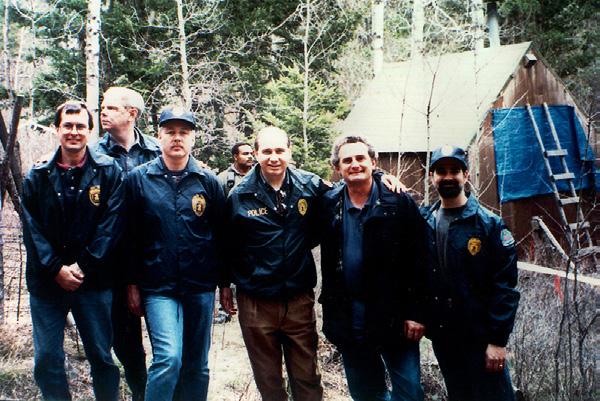
Going back to and concluding the history of the USPS, the most recent significant evolution of the postal service was the introduction of ZIP, standing for “Zone Improvement Plan” codes in 1963. These five digit numbers, attributed to Robert Moon, streamlined the sorting and delivery of mail for the postal service. In addition, it gave them a chipper cartoon mascot, Mr. ZIP, part of the extensive efforts to promote the adoption of the system as well as encouraging citizens to put the ZIP code on their outgoing mail.

In a 15 minute long informational film featuring 1960s folk band
“The Swingin' Six,” available via the National Archives on YouTube, the details of how the codes work are explained and the benefits, including faster service, lower rates, electronic sorting, aiding with determining where poorly written addresses are, specifying the location of cities that share names with other cities e.g. Springfield, Illinois vs. Springfield, Missouri, are touted through a series of catchy musical numbers complemented by questionable choreography.
Sadly, the future of a public postal service in this country is currently in question with the Trump administration in power. President Trump has flirted with
the idea of merging the USPS with the Department of Commerce. Head of the Department of Government Efficiency Elon Musk has mentioned privatizing the Postal Service. In March, Postmaster General Louis DeJoy, who was appointed during Trump’s first term, resigned leaving his Deputy Postmaster General Doug Tulino to take over until further notice. Tulino has announced a plan to cut 10,000 employees from the USPS’s payroll through the Voluntary Early Retirement program. On the flipside, they continue to push the “Delivering for America” plan that was introduced in 2021 and aims to modernize the postal service. However, the plan has been criticized by sides of the aisle as some of the measures disadvantage certain ZIP codes, specifically rural ones. A positive mention though and a visible modernization effort is the purchase of new carrier vehicles. The “Next Generation Delivery Vehicle (NGDV)” manufactured by Oshkosh Defense of all companies, is slated to replace current standard Grumman “Long Lasting Vehicle (LLV),” which over the past decade has gained a reputation for spontaneously combusting with at least 407 catching fire since 2014 with approximately 120 of those being noncrash-related incidents. The postal service plans to acquire 106,000 of the vans through 2028. It will certainly be interesting to see how the USPS will continue as a constant in our country and build on its legacy.
An early graduation celebration for the 13 early graduates from the Class of 2025 was held on January 16. Family, friends, teachers, and administrators gathered to honor the first Fox Chapel Area High School Class of 2025 graduates. Congratulations to those who received their diploma!
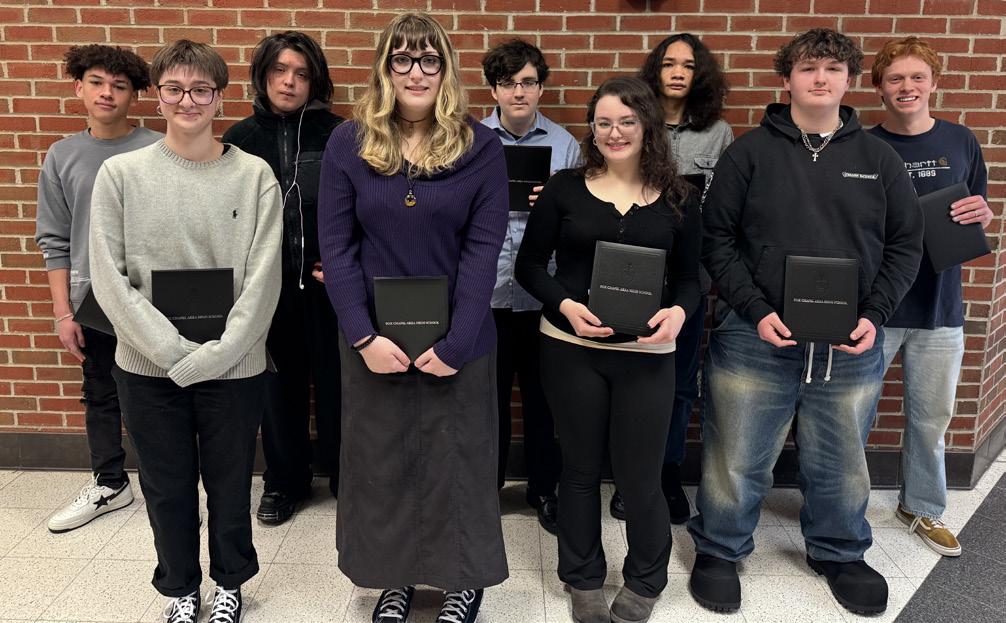
On March 5th, the annual BotsIQ Robotics Preliminary Competition took place. This event was part of an yearlong effort to build a robot from scratch, with students completely designing and assembling parts as well as documenting the process. Led by Mr. Siniawski, students in Robotics Club have most of the school year to design and build their robot and then put it into multiple competitions. At competitions, the robot is put into multiple fights where it battles another robot for three minutes until one robot is destroyed, inspiring innovation and forcing students to create hardy and maneuverable robots.

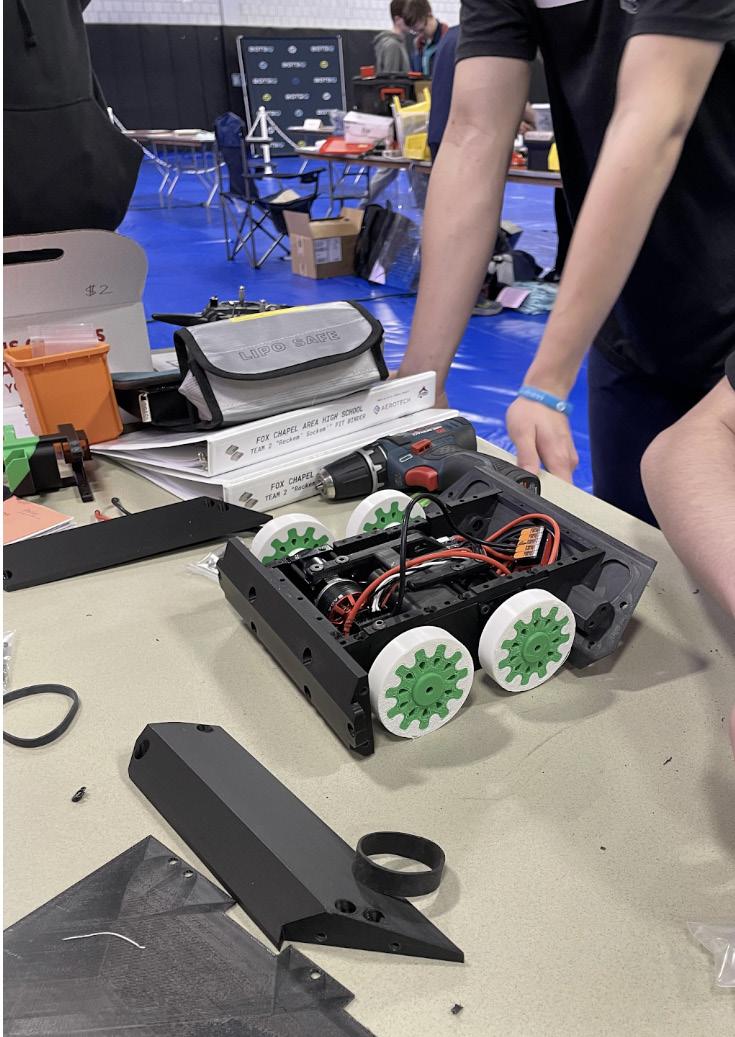
When made maneuverable, they can easily get around the enemy’s weapon to avoid being hit and attack them on the enemy’s weaker sides. The weapons consist of a variety of shapes and angles
FBy Mateo Phelan-Videl
which spin around. The most basic weapon is a large and hard piece of metal spun at a high velocity to destroy the enemy’s armor and electrical components. Throughout the season, these robots from around 60 teams compete in preliminaries, regionals, and finally nationals. Fox Chapel High School’s robotics team has earned two grand championships over the last two years under technology educator Mr. Siniawski’s leadership. They plan to carry another trophy home this year! Good luck FC Robotics!
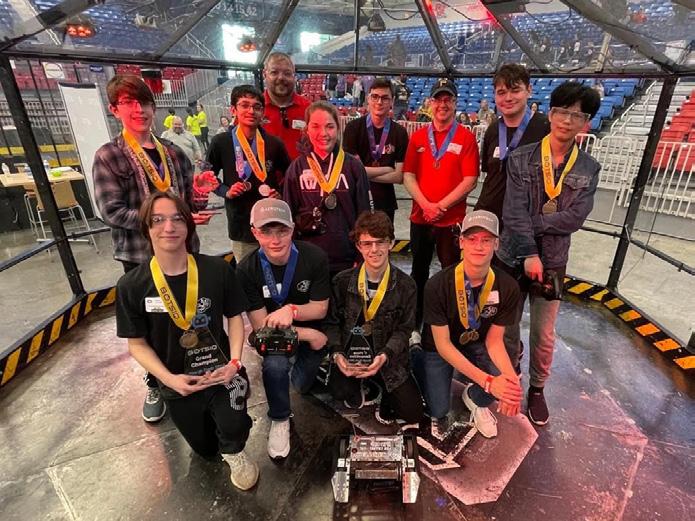
ox Chapel Area High School junior Mira Owens had her artwork selected for the 2025 National Art Honor Society/ National Junior Art Honor Society (NAHS/ NJAHS) Juried Exhibition. Mira’s piece is titled “Reminiscence,” and is a drawing using all the ink in one pen. According to Mira, “I illustrated my dance experience during quarantine. Dance kept me connected to people and music when everything else seemed out of reach. Dancing is like drawing because proper technique takes time; lots of practice must be dedicated to it.”

Mira’s artwork is being exhibited virtually, along with 129 other selected pieces, on the National Art Education Association (NAEA) website at https:// www.arteducators.org/national-art-honor-societies/ articles/2399-2025-nahs-juried-exhibition from March 11-August 31, 2025. The exhibition showcases the work of talented student artists who are members of NAEA’s NAHS/NJAHS programs.
A record-breaking total of 2,587 submissions were received for this year’s exhibit representing
72 schools from 31 states and South Korea. The submissions were juried by NAEA arts leaders and were judged on visual communication, execution, formal elements, originality, and artist statement. The NAHS is designed specifically for high school students in Grades 9-12. In 1978, NAEA began the National Art Honor Society program to inspire and recognize students who have shown an outstanding ability and interest in art. NAHS strives to aid members in attaining the highest standards in art scholarship, character, and service, and to bring art education to the attention of the school and community. Fox Chapel Area High School has an active chapter of the NAHS.
The NJAHS is designed specifically for middle school and junior high school students in Grades 6-9. In 1989, NAEA began the National Junior Art Honor Society program to inspire and recognize students who have shown an outstanding ability and interest in art and to generate interest in art programs at the secondary level and beyond.
"The Tremendous Trump Trade War" Pg. 14
https://www.pbs.org/newshour/economy/wall-street-tumbles-to-its-first-correction-since-2023-amid-trumpsescalating-trade-war
https://www.reuters.com/markets/us/investors-flee-equities-trump-driven-uncertainty-sparks-economicworry-2025-03-10/
https://www.wsj.com/business/retail/tariffs-walmart-target-home-depot-china-negotiations-c2de9436
"A Brief History of the U.S. Postal Service" Pgs. 15-16
https://www.historyassociates.com/usps-history/ https://constitution.congress.gov/browse/essay/artI-S8-C7-1/ALDE_00001068/ https://postalmuseum.si.edu/ https://www.history.com/articles/mailing-children-post-office
https://www.smithsonianmag.com/smithsonian-institution/brief-history-united-states-postal-service-180975627/
On Tuesday, February 4th and Wednesday, February 12th, 26 students from Fox Chapel Area High School competed in the PA Bar Association's Mock Trial Competition at the City County Building in downtown Pittsburgh. Close to 30 schools in the region participated in this year's competition. This is a highly competitive event that requires hours of both individual and group preparation.
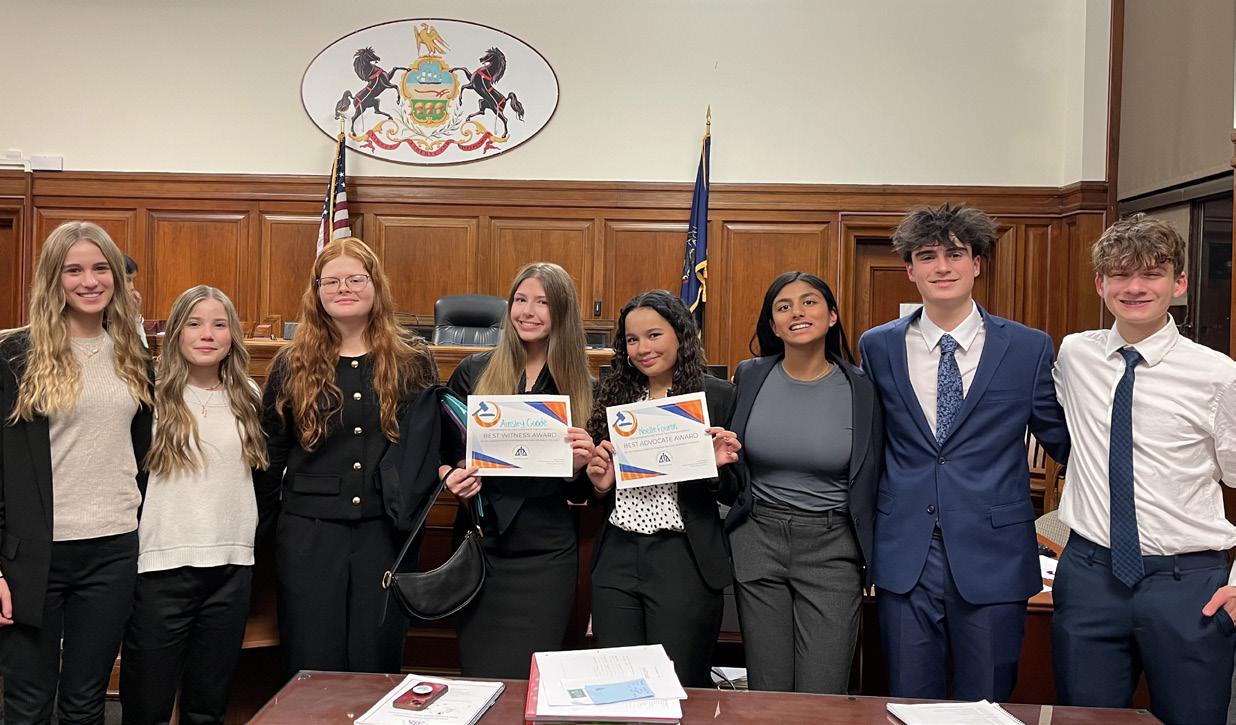
Owen George and Marianna Iannarelli.
Defense: Anna Chrissis, Aislynn Senn, Braxton Bielawski, Nico Zgurzynski, Ava Carey, Madelyn Bell and Marianna Iannarelli.
Fox Chapel entered two teams, each divided into Prosecution and Defense who competed separately. Team two's Defense succeeded in winning their trial over Avonworth on February 12th. Congrats to all the students who participated and even those who served as alternates during the competition season!
The following students participated in this event:
2/4/25 - Fox Chapel Team One: Prosecution: Margaret Handron, Aislynn Senn, Ariana Stevenson, Nadre Digbohou, Hannah Parker,

The Pennsylvania Bar Association's Mock Trial Competition gives over 290 high school student teams from across the state the opportunity to act as lawyers and witnesses in simulated civil trials before actual judges and panels of juries. It is among the largest high school mock trial competitions in the nation.
2/12/25 - Fox Chapel Team Two: Prosecution: Gabriel Yassin, Alessandra Sirio, Devon McDonald, Ellie Passavant, Victoria Macklin, Greta Erdner and Hannah Shuttleworth Defense: Noelle Fouron, Aiden Drucker, Laila Golla, Ainsley Goode, Emily Shaw, Collin Fasanella and Hannah Shuttleworth.
Thank you to the Fox Chapel Area HS Administration for your continued support for our organization! A special thank goes out to Dr. Patterson for coming to our February 12th competition — so nice to be able to show off our hard work!
- The FC Mock Trial Club
by joe yoshikawa
After the 2023-2024 season, the future didn’t look too bright for the Fox Chapel boys’ basketball team. Not only were they losing starters in the senior class, but conference realignment would hit the team hard. They had been moved from 5A to 6A, where they faced increasingly difficult competition from bigger schools.
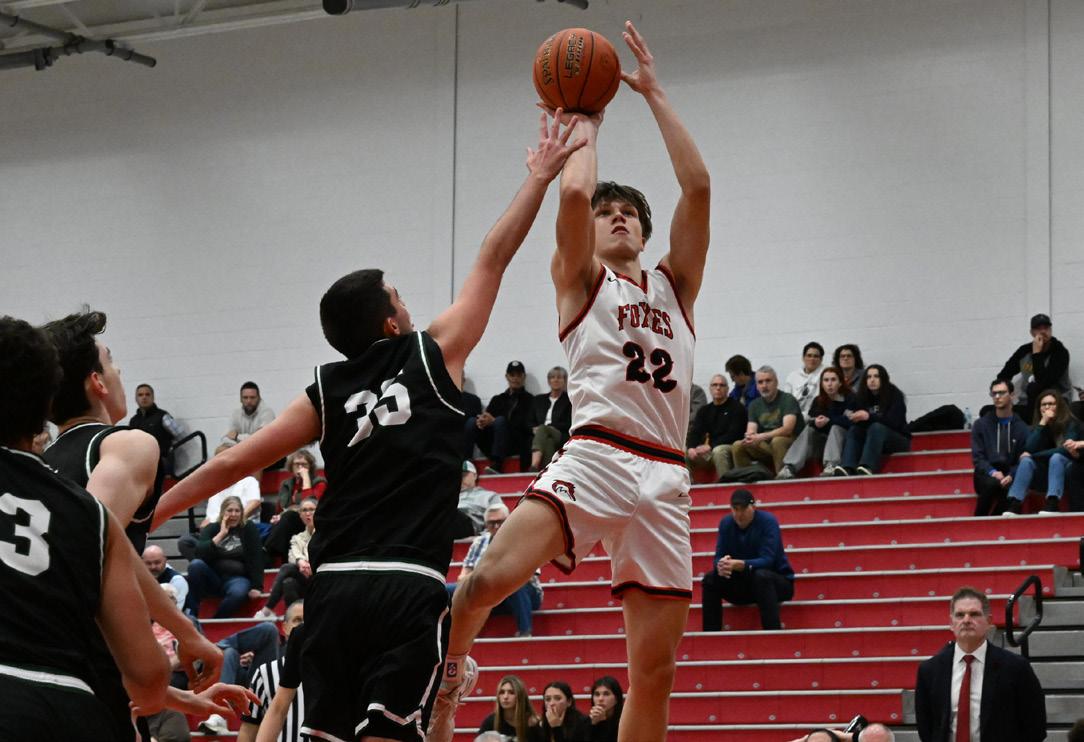
Lots of adjustments would have to be made from both the coaching staff and players, but that wouldn’t stop them; the Foxes have been prone to obstacles for years and always adapted quickly. During the 2023-2024 season, sophomore forward John Rehak suffered a gruesome ankle injury midway through the season. It would keep him sidelined through the rest of the season, and he was even questionable to play the following year. Yet, both the team and Rehak persevered. Players waiting for their chance got their moment, and they delivered. They built off their strengths and willpower that they already possessed and made it to the WPIAL and PIAA playoffs.

determination.
One concern brought up by head coach Zach Skrinjar was the team’s lack of a true center. Nobody on the team stood taller than 6’4” and fit the mold of a stereotypical “big man.” Yet, this didn’t stop Fox Chapel at all. It taught the team to learn the art of defense, and enabled even the smallest on the court to guard any player. They lowered the amount of points they let up per game, and had an above average amount of rebounds and steals.
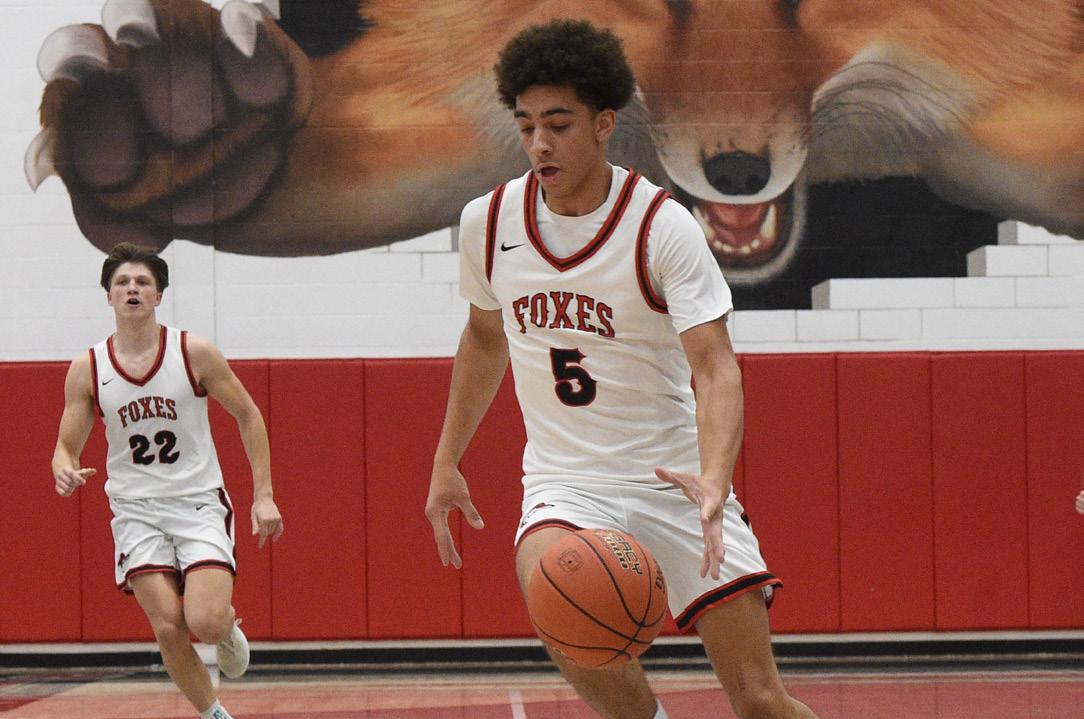
A highlight of this year’s Foxes team was their win at PPG Paints Arena. In overtime, they beat the Peters Township Indians 59-50. Their offense exploded with 15 points after the end of regulation time, while the aforementioned defense was able to hold Peters Township to a mere six points. This win finally put Fox Chapel in a bigger spotlight, showcasing they had the skills to beat the bigger teams that stood in their way.
While the season didn’t result in any trophies being added to the collection, the strong showing illustrated that Fox Chapel was built to handle adversity. Rehak worked to be ready by the 2024-2025 season, and at season’s debut, he was a contributor in the 58-50 win against Shaler. Building off this momentum, the Foxes went 8-2 through the 2024 calendar year. What they lacked in size or talent, they would make up with through their

By the end of the season, the Foxes had shut down the original narrative about them. Once projected to be an average team, they were on watch while cruising to the top of the section and battling it out with the toughest basketball teams in Pittsburgh. By the end of the regular season, they were 16-7 and finished second in the section. While they may have lost in the first round of the WPIAL playoffs, they should be proud of how they performed despite the disadvantages they faced.

Fox Tales’ Laila Golla interviewed athletes, mostly seniors, participating in spring high school athletics and asked questions regarding their growth in the sport they play and advice they would give to future teammates. She asked each athlete the same three questions:
1. What is your favorite part of being part of your sports team at Fox Chapel?
2. What is the most valuable thing your sport has taught you?
3. What would you tell future athletes thinking about joining the team?
Here are their responses.
1. My favorite part of being on the baseball team is being able to enjoy playing, improving, and winning games with my friends alongside getting to compete every year for a deep playoff run.
2. The most valuable thing baseball has taught me is the importance of working as a team rather than being a bunch of individuals.

3. To athletes considering trying out for the baseball team, I would say absolutely do it! The biggest factor that helped me be successful would be doing my best to get bigger and stronger, not only on my baseball skills.

1. My favorite part of being on the Fox Chapel lacrosse team is the incredible relationships I’ve built with my teammates and coaches. The bond we share, both on and off the field, makes every practice and game meaningful. I love pushing myself and the team every day, working hard with the shared goal of winning a WPIAL title.
by laila golla
2. Lacrosse has taught me that success is rewarded through hard work, dedication, and perseverance.
3. Joining the lacrosse team has been the highlight of my high school career. The friendships, lessons, and memories I’ve gained will last a lifetime. If you’re thinking about joining, go for it — you won’t regret it!
1. My favorite part would be practicing and playing with my buddies on the team.
2. The most valuable thing I've learned is to be coachable. If you're not coachable, you're not going to grow as a player.
3. Finally, something I'd tell future lacrosse players is to have fun playing on the team. The team has great coaches and players who are there to help you so that you have all the tools needed to be successful.

1. My favorite part is the relationships and memories I have made over these past few years that I'll have for the rest of my life.
2. The most valuable thing I have learned from softball is that sometimes things can get really difficult, but if it is something you love then it is worth pushing through the hard times.

3. Every athlete has bad days, but a good athlete pushes through and continues to work hard.

1.My favorite part of being on the softball team at FC is the friendships that I have developed while getting to play my favorite sport.
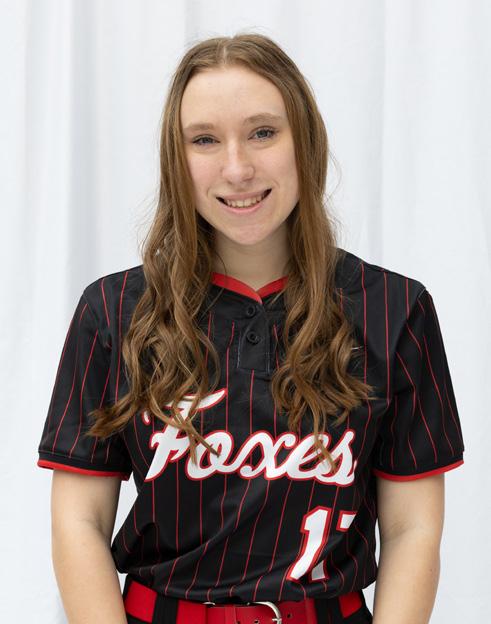
2. The most valuable thing that softball has taught me is to keep your head up after one bad at-bat or error in the field. You only get as long as it takes for you to make the mistake to keep thinking about it.
3. One thing that I would tell future athletes thinking about joining the softball team is such a mental game, do not let one mistake get you down. Also, make sure to come to practices and work hard, but make sure to still have fun!
mason friday - boys tennis
1. I most enjoy team camaraderie: competing together, supporting each other, and making great memories on the court.
2. Discipline and mental toughness is really important, specifically staying focused under pressure and always pushing to improve.

3. Keep a positive mindset, stay confident and learn from mistakes.
brooke fenton - unified track
1. My favorite part of being on the unified track team is how kind and uplifting everybody on the team is. I always leave practices and meets feeling better than I did beforehand.
2. The most valuable thing unified track has taught me is how important unified sports are in order to promote inclusivity and unity within our school. Unified track is a fun but competitive way to develop community and friendships between students that may not have had the chance to interact otherwise.

3. Do it! The unified track team is such an amazing community and being on the team is such a fulfilling and rewarding experience.
sarah michalak - girls track
1. My favorite part of being on the track team is competing at meets and running with my friends.
2. Track has taught me that hard works takes you far.
3. Track is super rewarding and if you put in all your effort you’ll be happy with the results.

ethan vaughan - boys track
1. I would say getting to spend time with friends and this chance to exercise/ compete.
2. The most valuable thing track has taught me is no matter how bad something is, it will be over eventually one way or another.

3. I would tell future athletes that are doing track would be that you can be good at anything if you try hard enough and keep at it (and join distance).

by marin airik
Do you wish you could participate in a teamlike setting but compete individually? Maybe you should remember to get onto the indoor and outdoor track roster next year! With so many different events to choose from, you can try out any event you want to see which one suits you best. Those of us on the indoor track team have had many great highlights and continue to train for outdoor track to keep up the fun.

In indoor track this past season, there were four regular meets for everyone to attend and one championship meet at the end. We all travelled to either Edinboro University or Youngstown State University to compete, and even though everyone had to wake up really early in the mornings, the meets were well worth the early wake up as everyone got so much experience and training! Edinboro University was always freezing, so next year remember to bring a coat and blanket.
If you need further convincing to join indoor track next year, there are a lot of food places outside of the Youngstown facility that many people visit after their events. The final Tri-State Championship Meet was hosted at Edinboro University on February 22nd. To attend the meet you need to hit certain time standards for running events and certain distance standards for throwing or jumping events. So many talented people attended the meet, and the distance team took home some medals! In the very first event of the day, the 4x800 meter relay, my team with fellow student athletes Zelia Herald, Bridget Hemingray, and Ella Shevshuck got sixth place and a medal! One of the most impressive feats of the day was performed by Ethan Vaughan, the cross country
WPIAL champion, who got second place individually in the 3000 meter run. One of the last events of the day, the boy’s DMR with Nicky Clump, Victor White, Harrison Parker, and Michael Costello, rounded out the day with 5th place and a medal. The DMR is the distance medley relay and the legs of the relay are the 1200 meter, 400 meter, 800 meter, and 1600 meter run. What a great start to preparing for the outdoor track season!

If you forgot to sign up for outdoor track this year, hopefully you remember next year. Do not worry if you are a freshman or sophomore scared of competing against older juniors and seniors; there are invitationals limited to just freshman and sophomores too! The competition may seem intimidating at first but we start our season out with a small scrimmage and dual meet to get prepared for the rest of the bigger meets. If you don’t like running short or long distances, you can always try out jumping and throwing; the high jump, long jump, triple jump, pole vault, javelin, discus, and shotput encompass that category. The options are endless and it never hurts to try something new.




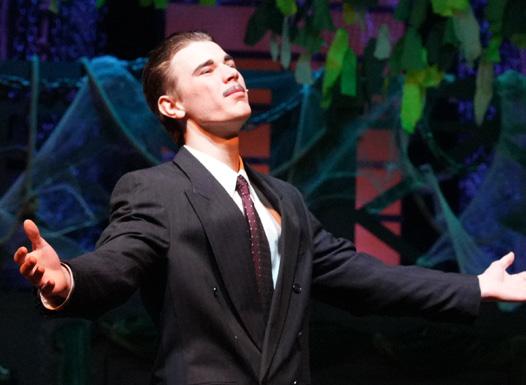
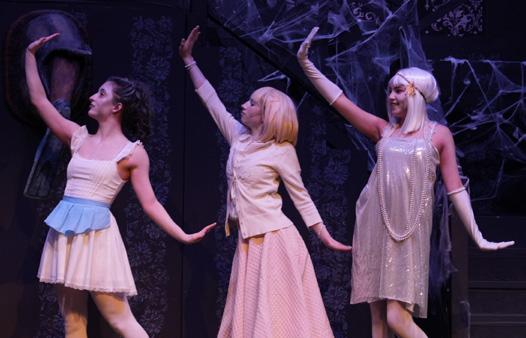
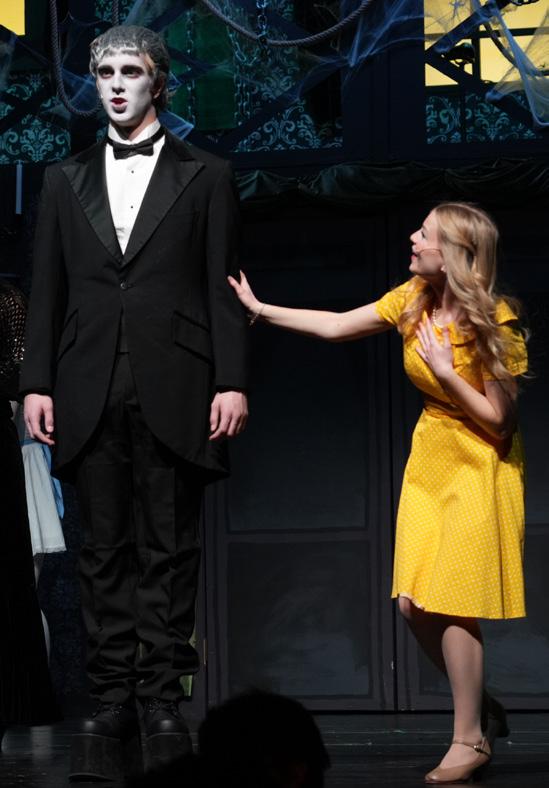






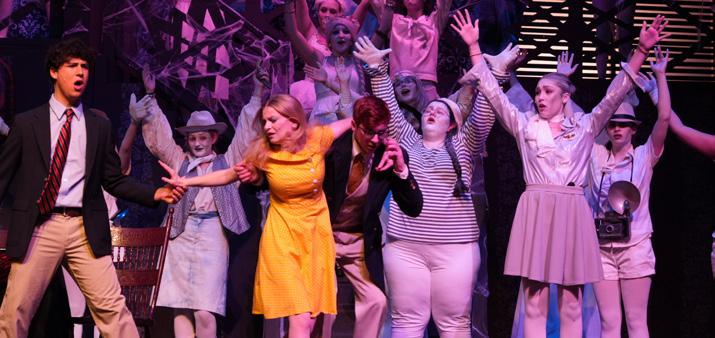
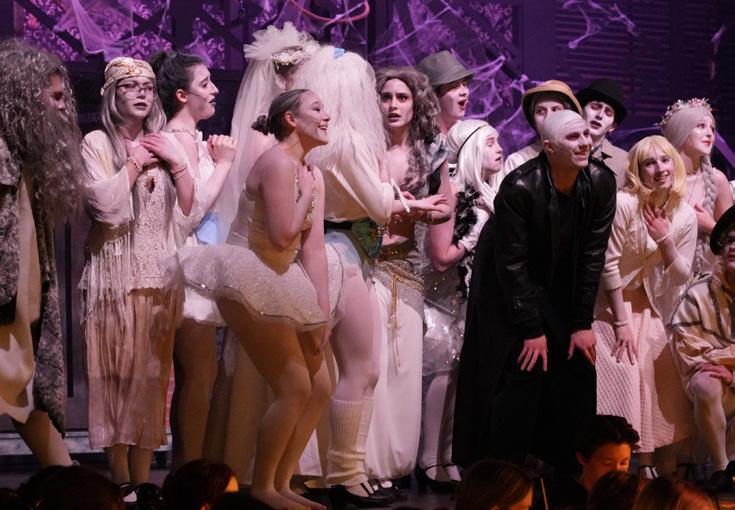


By Rishi Krishnamurthy
Imagine that you are a digital artist working on creating new avatars for a friend’s company. Unfortunately, you promised your friend that each avatar can be unique even if there were a million users each wanting their own avatar! How can you uphold your promise? My name is Rishi Krishnamurthy, and I am an eighth grader at Dorseyville Middle School. Every quarter, I write an article about numbers and mathematics. My plan is to continue this till I am a senior. So, make sure to check out A Math Minute every issue!
In the last issue, I began a series of articles that discussed the great minds of mathematics. Learning about the mathematicians of the past will give you an appreciation of the evolution of today’s mathematics and the main concepts that are important even today. I started the series by examining works of Euclid, Noether, and Gauss. I will tell you about more great mathematicians in a future issue; however, in this issue, I will be talking about a different idea: what the logarithmic scale is, and how it is used everywhere. At first, logarithms can be daunting. However, they have numerous real-world applications and are vital for many aspects of everyday life.
One of the most important properties of logarithms is loga(bc) = logab + logac. In other words, logarithms convert multiplication into addition. Therefore, to calculate the product of two large numbers b and c, you can simply take the logarithm of each number with any base a, add the two logarithms together to get the sum x, and your answer will be ax. This may seem difficult, but it is much simpler with large numbers to add than to directly multiply. Before the age of calculators, when slide rules were commonplace, this is what people did to speed up their calculations.

If you still have avatar anxiety about keeping your promise, you need not worry. To explain why, let me clarify the situation: let us suppose that for each avatar feature, a user has two options—for example, tall or short, glasses or not, etc. Consequently, with two features, a user would have 2 × 2 = 22 = 4 avatar options, and for three, 2 × 2 × 2 = 23 = 8 possibilities. With x features, accordingly, a user would have 2x possible avatars. So, how many features would be needed so that there would be a million unique avatars? That is where the logarithm comes in. From your math classes, you might have learned that if ax = b, then to solve for x, you would use a logarithm: x = logab, pronounced “log base a of b.” Thus, in order to solve for x in 2^x = 1,000,000, you would calculate x = log21,000,000 ≈ 19.9, and to have enough features for creating a million different avatars, you would only need twenty features!
As I mentioned earlier, there are numerous real-life applications of logarithms. A logarithmic scale allows exponential growth to be stated linearly, making it much easier to work with. The pH scale for acidity, the decibel scale for sound intensity, and the Richter scale for earthquake magnitudes are just three examples of scientific logarithmic scales. For example, if two earthquakes have magnitudes of three and six, the second earthquake is not twice as intense as the first. Instead, because the Richter scale is a “base 10” scale, the second earthquake is 10(6 – 3) = 1000 times more intense! However, if the Richter scale did not use logarithms, the numbers would be much less manageable—rather than the scale operating from one to ten, it would operate from ten to ten billion! An earthquake familiarly known with a magnitude of 6.8 would instead have a magnitude of 106.8 = 6,309,573, a much harder number to interpret.
When using the logarithmic scale to turn exponential data into linear data, we can also apply a method called linear regression. This helps us find a line-of-best-fit, which describes the correlation of the data points. For example, consider the four terrestrial planets. To compare their distances from the Sun with the time they take to orbit it, if we take the logarithms of these distances and orbital periods, the data fits a nice line, allowing linear regression. Once we find the line-of-best-fit, we can convert it back to an exponential relationship.
Math Minute Continued... Unfortunately, I could not find a book that details the various applications of logarithms. However, there are several online articles that describe these applications not only in science but also in finance, computer science, and several other fields. Instead of recommending a book on logarithms, I will suggest a book about infinity. Last year, I wrote an article about the incomprehensibility of infinity. I recently found a book written by Eugenia Cheng, titled Beyond Infinity: An Expedition to the Outer Limits of Mathematics. In this book, Cheng elaborates on many concepts precisely related to the incomprehensibility of this book, using real-life examples

for anybody to understand. Finally, as usual, I will end with a joke about mathematics. Picture a student in a band class playing the drums. The teacher asks the student to write down the rhythms while she assists other students. When the teacher comes back, the student is working on his logarithm homework! The teacher is upset with the student, but the student cheekily responds, “I am only doing what you asked. You told me to log-a-rhythm.” I hope you enjoyed this issue of Math Minute, and coming up, I will be continuing my series of famous mathematicians and also writing about probability and statistics.
The Fox Chapel Area High School library has been named the 2025 Outstanding Pennsylvania School Library. The award is given by the Pennsylvania School Librarians Association (PSLA).
According to Fox Chapel Area High School librarian, Dr. Laura Ward, each year, only one school library receives this prestigious recognition. “What makes me the most excited about this award is the idea that others see how great our library is. I’ve always known the library is the heart of our school, but now everyone can see just how wonderful it is,” Dr. Ward says.

The Pennsylvania School Librarians Association (PSLA) has deemed FCAHS's library the winner of the "Outstanding Pennsylvania School Library" award.
The recognition is being given to the Fox Chapel Area High School library because it exceeds the criteria with regard to the six foundations that are part of the American Association of School Librarians (AASL) National School Library Standards. Those standards are that school libraries are places where students are able to inquire, include, collaborate, curate, explore, and engage. “It's fantastic to see how our school library exceeds at incorporating the standards into everything that we do,” Dr. Ward says. “From collaborating with classroom teachers to engaging and connecting with not just the
students, but also our community, our library is making a difference in students’ lives.”
PSLA President Sarah DeMaria said in a letter to Dr. Ward, “The Fox Chapel Area High School library is an exemplary school library as evident in the programming, community outreach, and daily interactions you have with students and staff.” Mrs. DeMaria cited the Shelf Care Club as just one example of how the Fox Chapel Area High School library impacts students each day. The club was started by Dr. Ward and school counselor Rachel Machen, and is centered around self-care, but through books. “The Shelf Care Club is a way for students to practice self-care by reading and discussing books that focus on many mental health topics relevant to young adults today,” Dr. Ward says. “We read about challenging topics that provoke deep discussion and we look at how the characters handle different situations and how everyone in our discussion group relates to those characters.”
The award was presented at the 51st annual conference of the PSLA which was held at the Bayfront Convention Center in Erie, Pa., April 3-5.
Four students were selected by audition to perform with the 2025 Pennsylvania Music Educators Association (PMEA) Region I Band. The students are senior Marina Dunham (bassoon) and juniors Elliott Broyles (trombone), Jack Murray-Krezan (percussion), and Joshua Shah (flute). The band included 150 of the best student-musicians from 60 high schools from throughout Allegheny, Beaver, Butler, Fayette, Greene,
Lawrence, Mercer, Washington, and Westmoreland counties. The PMEA Region I Band concert was held March 8 at Ambridge Area High School and was conducted by retired Colonel Michael J. Colburn, the 27th director of “The President’s Own” United States Marine Band.
